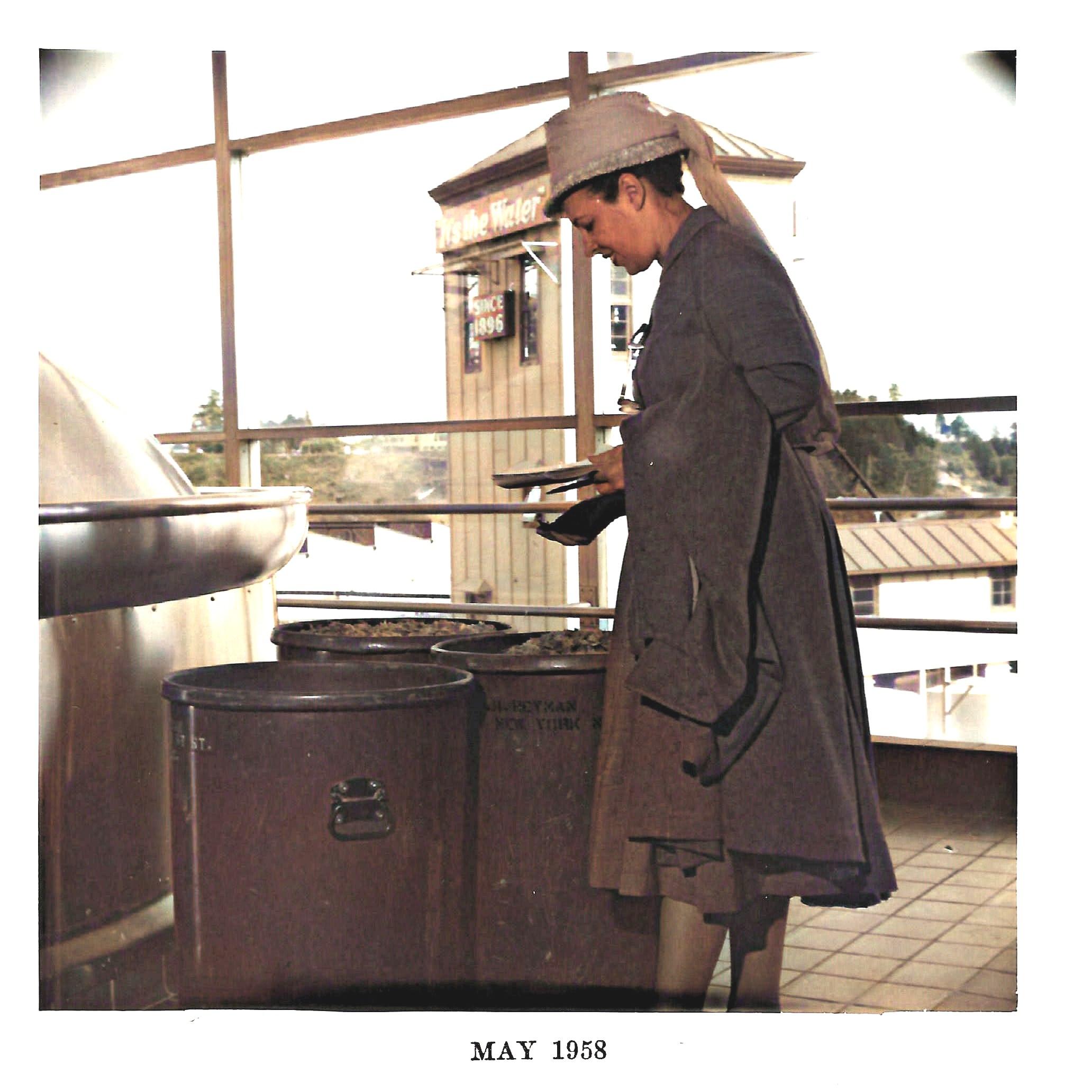






The Thurston County Historical Journal is dedicated to recording and celebrating the history of Thurston County.
The Journal is published by the Olympia Tumwater Foundation as a joint enterprise with the following entities: City of Lacey, City of Olympia, Confederated Tribes of the Chehalis Reservation, Daughters of the American Revolution, Daughters of the Pioneers of Washington/Olympia Chapter, Lacey Historical Society, Old Brewhouse Foundation, Olympia Historical Society and Bigelow House Museum, South Sound Maritime Heritage Association, South Thurston County Historical Society, Thurston County, Tumwater Historical Association, Yelm Prairie Historical Society, and individual donors.
Publisher
Olympia Tumwater Foundation
John Freedman, Executive Director
Lee Wojnar, President, Board of Trustees
110 Deschutes Parkway SW P.O. Box 4098 Tumwater, Washington 98501 360-943-2550
www.olytumfoundation.org
Editor
Karen L. Johnson 360-890-2299
Karen@olytumfoundation.org
Editorial Committee
Drew W. Crooks Jennifer Crooks
James S. Hannum Erin Quinn Valcho
The Journal does not offer a subscription service. To get your own copy, join one of the heritage groups listed at the top of this page. These groups donate to the publication of the Journal, and thus receive copies to pass on to their members. Issues are also available for purchase at the Bigelow House Museum, Crosby House Museum, and Lacey Museum, and occasionally at Orca Books in downtown Olympia.
One year after print publication, digital copies are available at www.ci.lacey.wa.us/TCHJ.
The Journal welcomes factual articles dealing with any aspect of Thurston County history. Please contact the editor before submitting an article to determine its suitability for publication. Articles on previously unexplored topics, new interpretations of well-known topics, and personal recollections are preferred. Articles may range in length from 100 words to 10,000 words, and should include source notes and suggested illustrations.
Submitted articles will be reviewed by the editorial committee and, if chosen for publication, will be fact-checked and may be edited for length and content. The Journal regrets that authors cannot be monetarily compensated, but they will gain the gratitude of readers and the historical community for their contributions to and appreciation of local history.
Opinions expressed by contributors are not necessarily those of the Olympia Tumwater Foundation
Written permission is required to reproduce any part of this publication.
Copyright © 2020 by the Olympia Tumwater Foundation. All rights reserved.
ISSN 2474-8048
Number 11
April 2020
2 Do You Remember The Fleetwoods?
James S. Hannum, M.D.
9 World War II on the Homefront Sharon Mallory Wood
32 Stormy Behavior Costs Olympia Police Chief, Assistant Chief, Their Jobs John Dodge
41 A Windstorm for the Ages John Dodge
Back Cover
Who/What/Where Is It?
On the cover:
The Fleetwoods circa 1960. From left to right: Gretchen Christopher, Gary Troxel, and Barbara Ellis. Photo used by permission of Gary Troxel at www.the fleetwoods.us/photo-gallery.html (accessed September 1, 2019).
See article on page 2.
This black-and-white photograph has been colorized using a new tool available through Legacy Family Tree. For more information or to colorize your own photographs, visit https://news.legacyfamilytree.com/legacy_news/2020/02/yourblack-white-photograph-to-full-color-in-1-step.html. The first few photo conversions are free; after that, you will need to pay a subscription fee.

A recent post on the website ThurstonTalk reviewed the rich history of musical creativity in the Olympia metropolitan area. Kurt Cobain (the lead singer of the group Nirvana) lived in the apartments at 114 Pear Street between 1989 and 1991. Some of his most noteworthy work was done during those years. Sleater-Kinney, a nationally successful rock band, was formed in the Olympia-Lacey area in 1994. The group took its name from Lacey’s Sleater-Kinney Road. Macklemore is the stage name used by rapper Ben Haggerty. He is known to have spent a significant amount of time hanging out in Olympia from 2004 to 2009.1
However, another group, The Fleetwoods, predates all of those performers. While exploring a West Olympia neighborhood in 2001, I conversed with a man who informed me that Gretchen Christopher lived nearby. At first, I did not recall who she was; the gentleman reminded me that she was one of the original singers in The Fleetwoods, a nationally-known group that had several hit recordings in the late 1950s and early 1960s. I was reminded of that earlier meeting in 2007, while attending a birthday party held for a neighbor, Fred Finn (now a former Democratic member of the Washington House of Representa-
tives). The Fleetwoods provided entertainment for that gathering.
I learned that in 2007, The Fleetwoods differed significantly from the members of the group during its heyday. The 1959 version of The Fleetwoods consisted of Gretchen Christopher, Barbara Ellis, and Gary Troxel. That year, they recorded their first hit record, “Come Softly to Me.”2
Troxel was the only member of the original trio who appeared in the performance I enjoyed in 2007. As is the case for many successful groups, a variety of factors gradually led the individual singers to diverging careers. The Fleetwoods’ contract with Liberty Records concluded in 1966, and the group chose not to renew it under terms that were less favorable than previous versions.3
For several years after 1966, the performers continued to appear in various combinations including two or three of the original members.4 Ellis retired from the group in 1974 and Troxel is said (by Gretchen Christopher’s website) to have resigned officially from the group in 1983. In the years that followed, Christopher managed separate groups on the East and West Coasts which she designated as “replacements” for The Fleetwoods.5 At
Gary Troxel’s group, The Fleetwoods, as it exists in the 21st Century. From left to right: Bonnie Hannukaine, Cheryl
2019).

the same time, Troxel performed with his own group called The Fleetwoods.6 It has been together for about 35 years, and still does shows.
The Fleetwoods should not be confused with Fleetwood Mac, a completely unrelated group. Fleetwood Mac was a rock band formed in London in 1967. Mick Fleetwood was an original member of the group, which eventually became popular in the United States as well as Great Britain.7

At least one website perpetuates a question about how the original members of The Fleetwoods chose the name of their group. Did the name memorialize the Cadillac Fleetwood automobile,8 or did it come from the designation of Olympia’s telephone exchange at the end of the 1950s?9 Gary Troxel answered that question in a 2019 email to the author: “It was the Fleetwood exchange word. When we appeared at Parker’s Ballroom (our first money-making experience), Bobby Darin thought it came from the Cadillac also, but we set him straight.”10 A similar statement is found in an interview with Gretchen Christopher.11
This leads to the question of how FLeetwood (the first two letters of any exchange were customarily capitalized) was selected as the name for Olympia’s telephone exchange. A recently-circulated notion declares that the name was selected to honor a pioneer family in the Lacey-Olympia area.12 The head of that family was Shadrick Fleetwood. He was born in Jackson County, Indiana circa 1826-
1830. His son, William Washington Fleetwood, was born in Monroe County, Indiana in 1850. William’s brothers, Asa and David Fleetwood, were also born in Monroe County; Asa in 1854 and David in 1855. Shadrick lived in Scotland County, Missouri in 1860. Another of his sons, James Marion Fleetwood, was born at Oregon City, Linn County, Oregon in 1867. By 1870, Shadrick and his family were residing in the Puyallup Valley of Pierce County, Washington. All of them had moved to Thurston County by the time the 1880 Washington census was taken. Shadrick Fleetwood died in 1884 and was buried (as “Chadrick” Fleetwood) at the Ruddell Pioneer Cemetery, located at the intersection of Ruddell and Mullen Roads.13
Lyman Albert Fleetwood, DDS, was a grandson of David Fleetwood. Before Lyman passed away in 2009, he was interviewed by local historian Amber Raney. She questioned him about a possible link between the Fleetwood family and the name chosen for the Olympia telephone exchange. Lyman noted that his family had had no special relationship with the telephone company, and the name did not memorialize any of his ancestors.14
Those who are familiar with local maritime history may recall that S.S. Fleetwood was part of the Puget Sound mosquito fleet. That steamship
provided Thurston County with reliable transportation in the late 19th Century. Built in Portland, Oregon in 1881, S.S. Fleetwood operated between Astoria and various Columbia River ports during its early years of service. The ship was sold, and brought to Puget Sound in 1888, where it made a daily round trip between Olympia and Seattle. Later it was placed on the Tacoma-Seattle route.15 No credible evidence has been found to suggest a linkage between S.S. Fleetwood and the FLeetwood telephone exchange.
FLeetwood first appeared as the Olym-
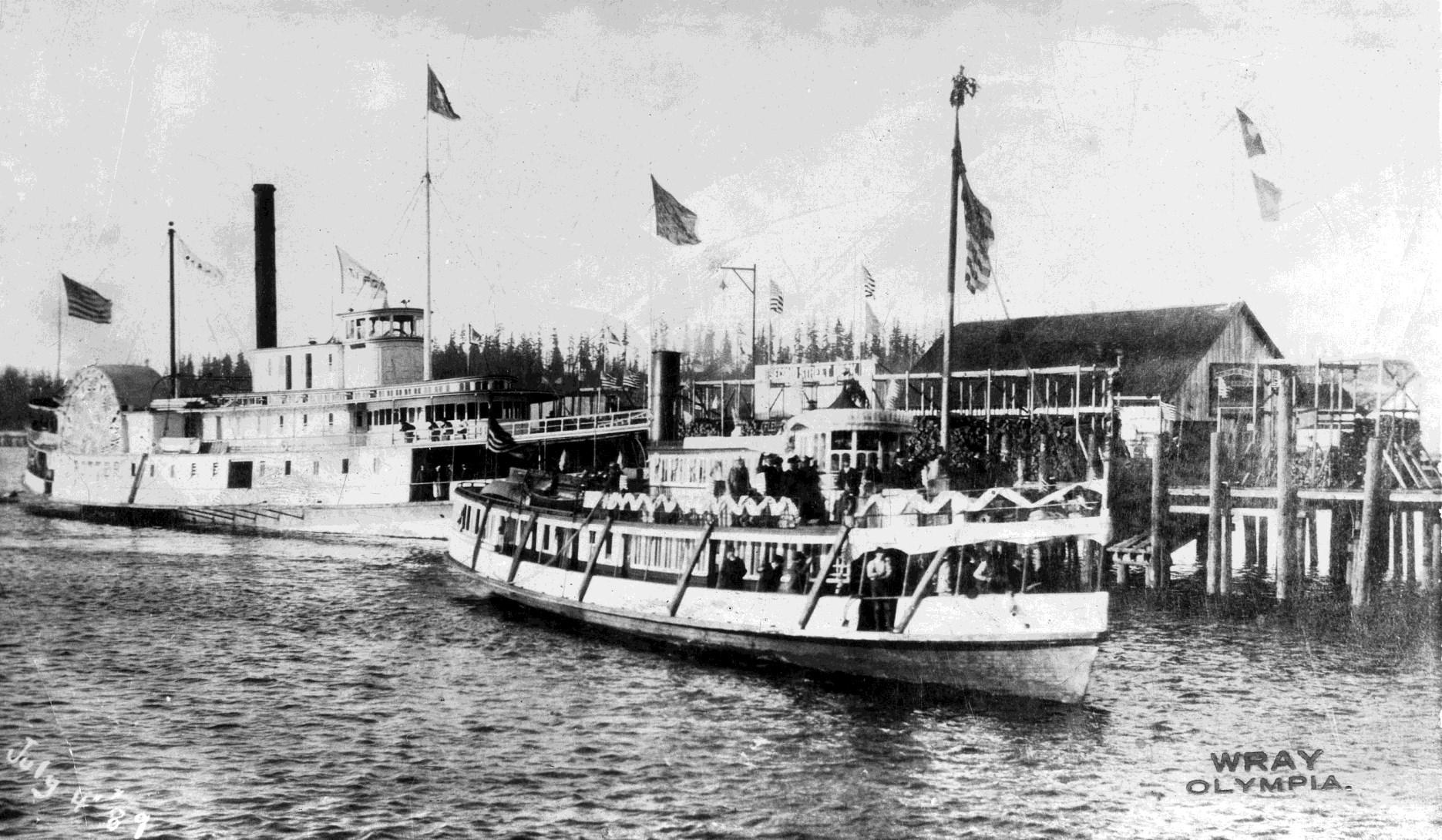
In 1898, the S.S. Fleetwood was abandoned on Vashon Island. This view from 1908 shows the ship wrecked on the beach at Quartermaster Harbor. Photo by Asahel Curtis, courtesy of Washington State Historical Society. www.washington history.org/collections/item.aspx?irn=148720 (accessed September 1, 2019).

pia exchange name in the 1955 telephone directory; it remained in use through the 1961 issue. FLeetwood was no longer used in the 1962 and later directories. Prior to 1955, Olympia was already using 352 and 357 as the initial digits in some of its local telephone numbers.
AT&T published Notes On Nationwide Dialing in 1955. It contained a list of names that were recommended for exchanges, in order to minimize the chance of misunderstanding when the name was spoken. The list was to be
applied to new exchanges only. Existing ones would not be altered. For the initial number 35, the list included FLeetwood (as well as ELgin, ELliot, ELmwood, and FLanders).16
The building at 119 7th Avenue SE, in Olympia, was constructed circa 1938 to serve as offices for the Pacific Telephone & Telegraph Company. Located on the south side of 7th Avenue, across from Sylvester Park, it became known as the Fleetwood Building when FLeetwood was adopted as the name for the
Olympia exchange.17 It continues to be known as such. Currently, it provides low income housing.
Thus, it seems that the name Fleetwood has been a significant part of Thurston County history for many, many decades. Nonetheless, the only direct historical connection of The Fleetwoods is with the fleeting FLeetwood telephone exchange.
-to-me (accessed September 1, 2019).
4 Michael Jack Kirby. “The Fleetwoods.” From Way Back Attack. www.waybackattack.com/fleetwoods. html (accessed September 1, 2019).
5 “The Fleetwoods Today.” www.thefleetwoods.com/fleetwood sbio.html (accessed September 1, 2019). The replacement groups were also called The Fleetwoods.
1 Holly Reed. March 30, 2019, “Following in the Footsteps of Famous Musicians Who Lived in Olympia.” www.thurstontalk.com/2019/03/30/ following-in-the-footsteps-of-famousmusicians-who-lived-in-olympia/ (accessed September 1, 2019).
2 Howard A. DeWitt, “The Fleetwoodsthen and now: Teen Angst and Soft Rock ‘n Roll.” www.thefleetwoods. us/biographies/thefleetwoods-then-anow.html (accessed September 1, 2019).
3 Fred Bronson. April 13, 2019, “The Fleetwoods’ Gretchen Christopher Reflects on Topping the Hot 100 60 Years Ago Today.” www.billboard.com/ articles/columns/ pop/8506925/thefleetwoods-gretchenchristopher-come-softly
6 Howard A. DeWitt.
7 Fleetwood Mac. www.rockhall.com/ inductees/fleetwood-mac?gclid= CjwKCAiAvonyBRB7EiwAadauqXa7x5oN_qtZzn2jxLVlrWhfFN_pSpvjA tazd1Hvyv0YpIUDsxnnTBoCDAQQAvD _BwE (accessed February 11, 2020).
8 “The Fleetwoods.” History of Rock. www.history-of-rock.com/fleet woods.htm (accessed September 1,
The Fleetwood Building at 119 7th Avenue SE in Olympia. Photo courtesy of Deb Ross (2013), Fleetwood Building. https://olympiahistory.org/fleetwoodbuilding/ (accessed September 1, 2019).
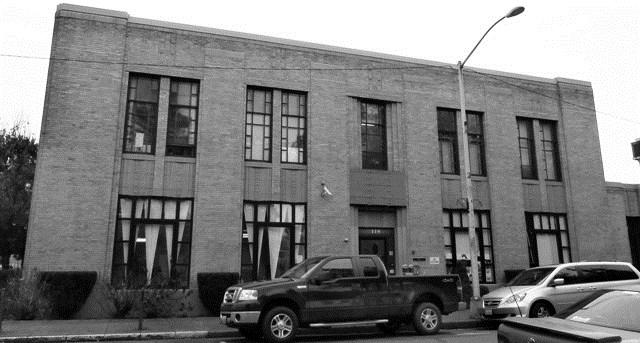
9 Nick Greene, “Why Did Old Phone Numbers Start With Letters?” Mental Floss . www.mentalfloss.com/ article/61116/why-did-old-phonenumbers-start-letters (accessed February 11, 2020).
10 Dick Parker’s now-demolished roadhouse was located at 17001 Aurora Avenue North, in Seattle. Casey McNerthney, “Parker’s Ballroom, longtime north end dance hall, demolished.” Seattle Post-Intelligencer, December 9, 2012. Bobby Darin (1936 1973) was a singer, songwriter, and actor popular in the 1950s and 1960s. Sally Hammond, “Bobby Darin’s Regards to Broadway.” The New York Post, September 30, 1967.
11 Fred Bronson.
12 Fleetwood Building. Olympia Historical Society and Bigelow House Museum. www.olympiahistory.org/ fleetwood-building/ (accessed September 1, 2019).
13 FamilySearch. www.familysearch. org/search/ (accessed September 1, 2019).
14 Personal email from Amber Raney (received August 29, 2019).
15 E. W. Wright, Lewis & Dryden’s Marine History of the Pacific Northwest. Portland, Oregon: Lewis & Dryden, 1895, pages 284, 292, 336. www.ar chive.org/details/cihm_16505/page/
n1/mode/2up (accessed February 11, 2020).
16 “List of Suitable Central Office Names,” Notes on Nationwide Dialing. American Telephone and Telegraph Company, Department of Operation and Engineering, 1955, Section II, Appendix A, page 1. www.explodingthe phone.com/hoppdocs/nond1955.pdf (accessed February 11, 2020).
17 Fleetwood Building.
Dr. Hannum is a retired physician and surgeon who spent his early years in Michigan. He arrived in western Washington in 1971 as a member of the U.S. Public Health Service. Railroad history has been a life-long interest, and he has written several books on the subject.
Editor’s note: Sharon Mallory Wood grew up in Olympia, and was eight years old when the U.S. entered World War II. Here she recounts her memories of that momentous time in our history. Dates and statements about the war were checked for accuracy.
This tale must begin with some background on World War I (WWI) rather than World War II (WWII) itself. It is hard to conceive that within a period of about 25 years most of Europe and Asia would be completely engulfed in war, not once, but twice. Both times the German military forces were one of the catalysts. The reality of WWI so greatly influenced the attitudes of the American people just prior to and during WWII.
WWI erupted in 1914, but the United States managed to remain neutral and somewhat isolationist for nearly three years. We were convinced it was not our battle to fight. Finally, in 1917, it became “our war” as well. The American Expeditionary Force was composed of young men from every occupation and strata of American society. Both volunteers and draftees, they were now convinced of the need
Sharon Mallory in the late 1930s, with her maternal grandfather Frank Kenney, just a few years before the beginning of World War II. Photo courtesy of Michael M. Wood.

to stop the German Kaiser from overrunning Europe. These young volunteers, like none after them, marched off to war amid bands, flags and the cheers of their townspeople. They set off to “win a lasting peace.”1
After a few short weeks of training, these soldiers were shipped “Over
There.” They fought in the trenches and mud of Europe, many of them in hand-to-hand combat with other young enemy soldiers. Ernest Mallory of Olympia was one of those enlistees in the 91st Division, composed of men from throughout the western United States. He served as an ambulance driver in France and Belgium. He was in the midst of some of the worst combat of that war as a young corpsman. He told how the ambulances, marked with a red cross, became prime targets for enemy fire. Many a time, for lack of proper supplies, he was forced to dissolve morphine in his hand from the water in his canteen to ease the suffering of the wounded. [Read more about Ernest Mallory’s ambulance service in “Olympia Boys: Heroes of Audenarde Battle” in the April 2019 issue of the Journal.]
WWI was “The Great War” the “War to End All Wars.” When the allies were victorious in 1918, Ernest Mallory was one of the men who marched down the Champs-Élysées and through the Arc de Triomphe in Paris with his few remaining comrades. It had been a terrible, bloody conflict! The British alone lost one million men in those trenches. No one ever thought that the United States would have to fight in Europe again. Supposedly, we had “saved the world for democracy.”2
dictator, with a similar lust for power, had gained control of Italy. He and Hitler quickly formed the Axis Alliance in October 1936. The Japanese, under Emperor Hirohito and his cadre of military leaders, were intent on increasing Japan’s land holdings and resources by whatever measures, which prompted their invasion of Manchuria in the early 1930s. In November 1936 they joined the Axis powers.
These three nations soon became focused on the complete domination of Europe, Asia, Africa and the South Pacific. Their rule of terror too often included the cruel extermination of those people whom they despised. Little stood in the way of Hitler’s planned annihilation of the Jews, Roma, and other ethnic minorities, or of the Japanese slaughter of Chinese civilians, such as occurred at Nanjing in 1937. It was left to the Allied Forces of the United States, Britain, France, and Russia to block that march of conquest.
By the 1930s, barely fifteen years later, Germany had once again built a vast military machine under the leadership of Adolph Hitler and the Nazi Party. Benito Mussolini, a Fascist
In the early stages of growing world tensions, Great Britain tried to coexist with Hitler and downplay the probability of an all-out war. Despite the appeals of various world leaders, Nazi Germany invaded Poland on September l, 1939. Two days later France and Britain reluctantly declared war once again on Germany and its Italian ally. Despite the odds favoring fascist armies and navies, the United States tried to maintain its neutrality. More and more European countries fell under Axis domination.
Britain, still economically depressed from WWI, fought on, aided by a great deal of money, supplies, and assistance from the United States. Citizens across the U.S., including those of us in Thurston County, actively collected “Bundles for Britain” food and used clothing for the British who were undergoing intense bombing attacks almost nightly. Our neighbor, Roy King, a Brit, told of attending most of his grammar school in the underground bomb shelters of London. No one at home wanted to send American men to die again on foreign soil. Those
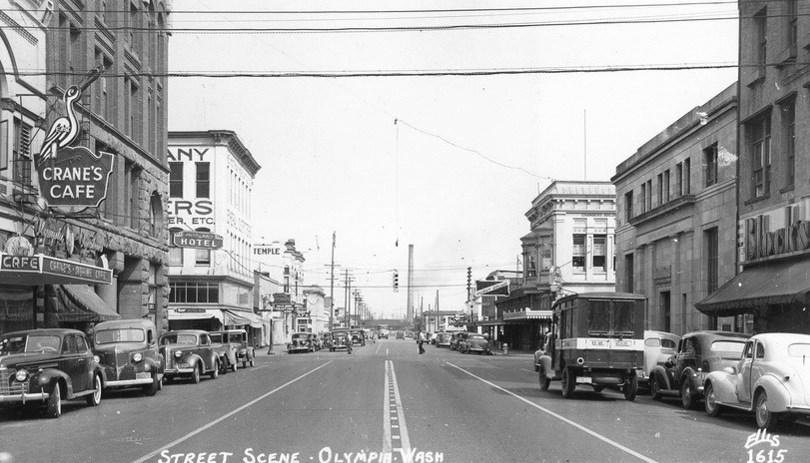
fathers who had fought in WWI could hardly believe such a sacrifice would now be required of their sons.
It was not until December 7, 1941, when the Japanese bombed Pearl Harbor, Hawaii, that full United States involvement became a reality. WWII now engulfed us as well! At that time the citizenry were led to believe that the Japanese had conducted a sneak attack a despicable act. In retrospect it was just “business as usual” in the undertaking of war. Thanks to President Franklin D. Roosevelt, December 7 became known as the “Day of Infamy.”
History has proven that President Roosevelt and other leaders knew the United States’ entry into WWII was absolutely inevitable. We had already broken several Japanese codes and even had forewarning of an attack at Pearl Harbor. For whatever reason, our troops were not alerted to the imminent attack. Our naval fleet and air force suffered great damage and loss of life. Nothing could have solidified this country more quickly or completely! America had been wronged by evil forces! Once again we answered the call to help save the world from the tyranny of Hitler, Mussolini, and Hirohito. Today this rhetoric might sound overly dramatic, but in the 1940s this was definitely the sentiment of the American public.
War affects every aspect of a nation’s life, even when fought on foreign soil. It consumes a country’s energies, capital, and its resources, most notably the lives of its young servicemen and women.
But now it is time to address what happens on the homefront during wartime, or at least what happened in the 1940s. I was only eight years old when Pearl Harbor was bombed and twelve years old on V-J Day when WWII ended. Therefore my recollecttions are from childhood. But they are influenced by the knowledge and insight I have since gained as an adult. So, here the story begins.
By October 1941 my parents had finally managed to complete the building of their very fashionable
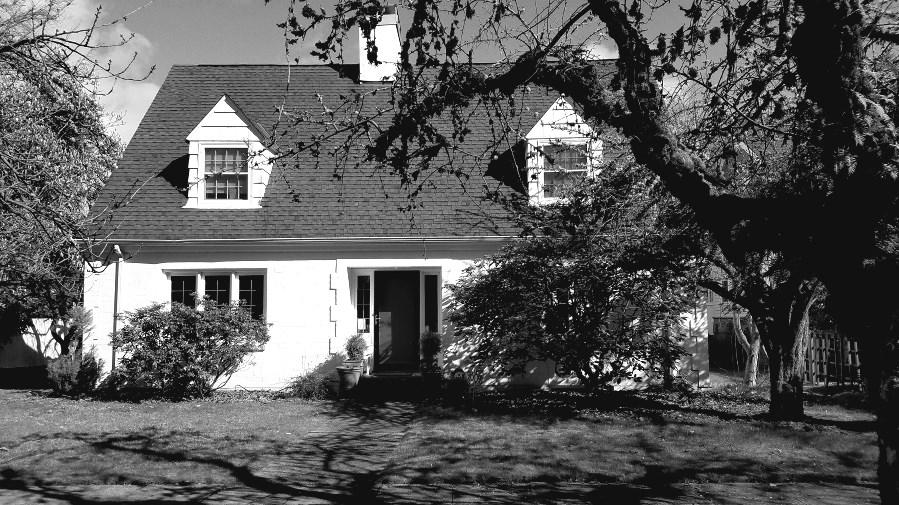
home in Olympia, Washington. It was newly decorated and landscaped and was considered one of the showplace residences of that “small town” capitol city. So it was with great pleasure and expectation that my parents had offered the use of their new home to a young woman friend, Frances Struthers, and her handsome U.S. Marine, Harold Shoberg. They were to be married December 20, 1941 in our front room, with a reception to follow.
Sunday morning, December 7, a neighbor phoned to say no more than, “Quick! Turn on your radio. All hell has broken loose!” I was eight years old and both frightened and intrigued to learn that the Japanese had bombed Pearl Harbor. We were going to war! As earth-shaking as that news was, it became even more significant in our household. We had to put on the wedding that very day! Harold was to report for duty and there was no time to lose. My father’s first call was to a local friend, Judge D. F. Wright a marriage license was needed. The judge had to open the local
courthouse, get the necessary documents signed, and stand by to officiate at the 7 o’clock ceremony that evening in case a priest could not be found on such short notice. My mother’s first call was to the bride and groom to assure them it was “full speed ahead.” Then she ran next door to Charlie Miller, the baker at the Olympia Bakery, who headed for his place of business to make an appropriate wedding cake.
Come noon my cousin Mary, also eight years old, and I were hustled off to a movie to get us out from underfoot for the afternoon. As we sat in the darkened theater, a message kept flashing across the screen ordering men in uniform to report immediately to their units. Many servicemen filtered out on their way back to nearby Fort Lewis and the Bremerton Naval Base. Mary and I were quite baffled about the location of Pearl Harbor. I remember assuring her it was at least fifty miles away. I knew we had little to fear!
Meanwhile, back at the wedding scene, my dad was rounding up liquor and ice from any and all friends who had extras in their larder. My mother assigned two friends to call the guest list, where she had indicated which guests were to bring a platter of hors d’oeuvres for the reception. Since flowers were not abundant in December, my mother arranged with a local nurseryman to bring armloads of greenery, mainly wild huckleberry and Scotch broom. Baskets were filled and what few white carnations were
available were added, along with yards of white ribbon. They made a small bouquet for the maid-of-honor, and a neighbor contributed a white prayer book and hankie for the bride to carry.
Evidently the greatest snag in “operation wedding” was that they were unable to reach the bridal attendant by phone in Tacoma. Repeated calls went unanswered. I have only a vague recollection that someone with a pretty long dress was to stand in at the last minute. Come 6 p.m., believe it or not, the bridesmaid rang our doorbell, dress and shoes in hand. She had no idea the wedding was taking place in an hour’s time. She had come to show Frances her ensemble and get her approval. She was hustled upstairs to my bedroom to get into the outfit, fix her hair, and get ready for the photos. My job that evening was to answer the door and to direct the ladies to the den, now serving as the coatroom.
What can I tell you? The groom was tall and handsome in dress blues, as was his best man. The bride was gorgeous in white satin (hastily pressed by my aunt Helen). The greens were fresh and lovely; the tiercake was beautiful; the drinks flowed non-stop with my dad tending bar from the kitchen; the canapés were as luscious as several good cooks could make them. It was a perfect wedding!
In the shadow of a terrible war, a real celebration took place.
Obviously I have many other memories of growing up in World War II, but this was the most special. It typified the spirit of resourcefulness that made the U.S. victorious. It also typified the sense of community and support that prevailed in Olympia and so many other towns and cities across America.
I should add a postscript that Harold survived the war and that he and Frances enjoyed a long, happy marriage until her death some years ago. Too bad my mother didn’t consider a career as a “wedding consultant.” But whoever heard of such a thing? That was to be part of another era.
I have included my memories of December 7, 1941 because our household’s experience in Olympia was perhaps unique. It’s hard to say what transpired in other homes. I do know that most families stayed near their radios since that was the only news source until the following day’s newspaper hit the stands. To quote a letter from a neighbor, Dr. Reed Ingham, “I was listening to the radio in my living room and suddenly called out to [my wife] Doreen, ‘Do listen to this! Pearl Harbor has been bombed! We are at war!’ I allege my remark was in moderate amounts of decibels, but Doreen suggests perhaps the whole south end of town got the news directly from me.”
Troops of all kinds Army, Navy, and Marines were quickly mobilized. My friend, Helen McKay Jacobs, said her father’s National Guard unit had been called to active duty some months previous. Others chose to enlist. The draft was initiated shortly thereafter and scores of young men all over the country received notices: “Greetings from the President of the United States
Reed Ingham as a college senior in 1930. Ingham later became a medical doctor. Photo from Tyee 1930 Yearbook, Seattle: Associated Students of the University of Washington, University of Washington Archives, page 99 (accessed February 18, 2020).
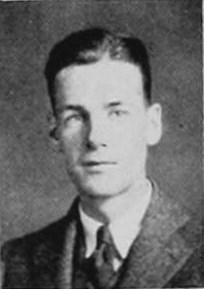
Reed Ingham offers some further insight on all of this:
“Although I was in the Medical Corps Reserve at the time, I held off signing up for duty at once since Doreen had some serious and puzzling medical problems. These were resolved the following spring at the Mayo Clinic. I then reported for duty, acquired my Captain’s uniform and expected to be mustered at once. But our military responds in surprising ways. I was rejected for active service at that time and, as a Captain in the National Guard, was assigned to duty as the Medical Director for Civilian Defense for the Olympia area.”
V-Mail letters were microfilmed before sending; 1,600 letters could be placed on a roll of film little larger than a cigarette pack. Photo courtesy of Office of War Information Photograph Collection, Library of Congress (accessed February 18, 2020).

My cousin, Mike Lee, who was about ten years my senior, joined the Marines and learned to became a para -trooper at Camp Lejeune, North Carolina. He was adored by all of the family; so handsome, full of fun and so charming. We were proud of him but so worried he would be killed.
My grandfather, Frank Kenney, who lived at Ken Lake, as did Mike Lee, made a pact with God that if Mike returned from the war in good shape, he would make a substantial contribution to the Catholic Church and would resume regular attendance. Of course, we learned of this after the war when Mike did return uninjured. However, he had participated in the bloody invasion of Okinawa Island and was one of the few survivors from his
unit. Most of his wartime experiences remain untold to any of the family. To the best of my knowledge, Frank did pay off on his pact. I did see him at Mass on a regular basis after the war.
While Mike was overseas, I used the wartime “V-Mail” to write to him. VMail was a thin sheet of writing paper that held the message on one side and the address on the back. You folded it into a square and licked the edges to seal it. These were then microfilmed and later reprinted at a destination depot in order to save valuable cargo space. You couldn’t get much news on one small sheet but it was extremely efficient. A first class stamp cost all of three cents and was emblazoned with the standard “V for Victory.” I wrote to
Cousin Mike about once a month. I’m sure he was less than thrilled to get correspondence from this kid at home, but he was my hero!
America’s young men were not the only ones to see active service; so did nearly 350,000 young women. Mainly they joined up to support the fighting men. First in uniform, as in the past, were the Army and Navy Nurse Corps. They were followed by the WACS (Women’s Army Corp); the WAVES (Women of the US Navy); SPARS (Women of the US Coast Guard); and WASPS (Women’s Air Force Service Pilots, attached to the Army Air Forces). According to National Geographic Magazine, the first American invasion forces reached North Africa on November 8, 1942. When our GI’s waded ashore under
heavy fire, more than 200 American girls, complete with packs and gear, were with them to serve as support troops. Throughout the war and even today the service and dedication of these young women has largely gone unheralded. Few memorials exist to honor their heroism.
Those women with families or who were not inclined to join the Armed Services were suddenly needed in the workforce. They had to replace those GI’s who had gone to fight and also to work in the defense plants that were popping up all over the United States. The entire country became focused on mass producing anything needed to run a war ships, planes, tanks, trucks, tires, equipment and clothing for the GI’s, medical supplies, munitions, radios, food, etc.
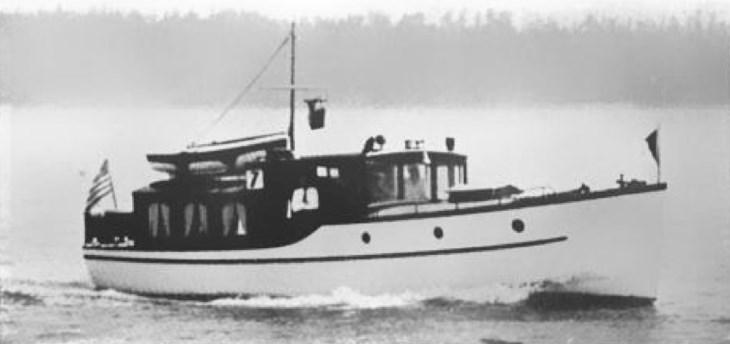
Women found that they could handle jobs formerly thought to be male territory. Hence the birth of the famous “Rosie the Riveter.” Women flocked to the shipyards and the defense plants.
Extended family members watched the children at home while many mothers were out making good money on the assembly lines. At the end of the war they were sent back home to give those jobs to the returning vets. But by then American women had tasted independence; the seeds for Women’s Lib had been planted during WWII.
My father, Ernest Mallory, was too old for active service but was soon commissioned in the Coast Guard Auxiliary. His boat, Pamanus, a 38footer, became part of the local Coast Guard fleet. It was painted gunmetal gray with large, black ID letters and numbers on either side of the bow. Ernest was assigned a crew of four to six men. For some unknown reason I remember that Andy Phillips, who ran the local hardware store, was one of that crew. Every Wednesday evening they patrolled the Olympia harbor, armed with pistols, rifles, and some type of radio communication equipment. They were on the lookout for enemy submarines and evidence of Japanese saboteurs. No doubt that statement will bring a smile or chuckle to some, but remember that Fort Lewis, one of the largest army depots on the West Coast, was just twenty miles away. Also, Olympia was the headwaters of Puget Sound and a port at which many supplies were loaded.
What Dad’s poorly armed crew would have done if they had sighted the enemy remains a mystery to me, but this was very serious business. We considered the Japanese fully capable of reaching our western coastline and the Germans, the east coast. In both cases that proved to be true.
Even my mother, Grace Kenney Mallory, became active in the war effort, helping at the Red Cross, rolling bandages for the troops. Those who could knit made sweaters, socks, gloves, and scarves for the fighting men. Grace also collected monies for the Red Cross, Bundles for Britain, and served food at the local U.S.O.
Even on the homefront, war can be devastating. It alters people’s lives and even whole communities. One of the worst abuses of WWII was the imprisonment of the American-born people of Japanese ancestry, along with other immigrants from Japan. There was a large Asian population on the west coast of the United States who became victims of the war because of their ethnic background. These people were easily identified by their looks and their names, unlike the Germans in our community. Due to a great fear of a Japanese invasion, infiltration or underground, the Japanese were rounded up by the troops under orders from President Franklin D. Roosevelt. Old and young alike were placed in concentration camps behind barbed wire. Later research shows that 161 Japanese
Americans were imprisoned from Olympia and Port Townsend.
In California, our relatives spoke of walking through some of the homes left abandoned by these JapaneseAmericans, still filled with furniture and other semblances of family life. The prisoners left home with what they could carry in their suitcases. The state confiscated their property homes, farms, shops, cars, acreage, etc. Other people living in the area were simply allowed to assume ownership of these abandoned properties without any reparation. One day these people were neighbors and the next day they were gone.
In Olympia we knew about the situation but no one seemed concerned or upset by it, believing that “the Government must know what it is doing.” After all, how could we possibly tell friendly Japanese from the enemy? Interestingly, those in many other states had little knowledge of the situation until after the war. It was a great injustice and only in recent years has the question of reparation been addressed. In this day and age we hear the words “civil rights” shouted from every TV set and headline, but during the war everyone was running scared. Many things were sensed to be potentially dangerous to the nation. The safety of society as a whole was deemed of far greater importance than the incarceration of an ethnic minority. It was one of the few times since the Revolutionary War that the United States faced enemies
powerful enough to invade our very land!
The United States population became absolutely focused on the war effort! There was a spirit of cohesiveness and camaraderie that has not been evident since. Everyone was involved, even we children. We all waited anxiously for news of the war which came by radio and through the newspapers and the newsreels which accompanied the weekly movies. The reality of the war became ever so evident when you walked the streets of Olympia and saw banners in the windows of so many homes. These banners bore a blue star for each member of the household who was in the service and/or a gold star for someone who had been killed in action. Although there was great sadness and horror at the death and destruction, there was also great vigor and enthusiasm for achieving victory. The country was sinking into debt due to the costs of the war but many companies and individuals were still making great profits. We had survived the Great Depression of the 1930s and now the country was back to work. If we could just crush the Axis, we knew we were on our way to prosperity.
Everything was needed for the war effort and to support our troops, so rationing became part of the times. It seemed to me that every item was rationed, or at least hard to come by tires, shoes, coffee, gasoline, sugar,
meat, butter, candy, and cigarettes. Ration books were issued to everyone and you forfeited a certain number of stamps, good for a limited period, to purchase a pair of shoes or a roast of beef. We all simply made do with what we had. Butter became a luxury, as did sweets. We used a spread much like Crisco yuck! Finally the spread, called Oleo, came with a capsule of yellow dye which you broke open and mixed with the Oleo. That only made it a wee bit more appealing. And, oh, to get a candy bar, a roll of lifesavers, a Tootsie Roll, or a pack of gum a real treat. All of us had meatless meals, where macaroni and cheese, Spanish rice, and hearty soups would be the main dinner courses. I very clearly remember taking sandwiches to school spread only with a mayo substitute enhanced with chopped sweet pickles. No meat or cheese. I
Ration books like these were used in Washington State during World War II. Rationed items included gasoline, sugar, meat, cooking oil, and other staples. Artifact from the Peter G. Schmidt Jr. Collection, Olympia Tumwater Foundation.
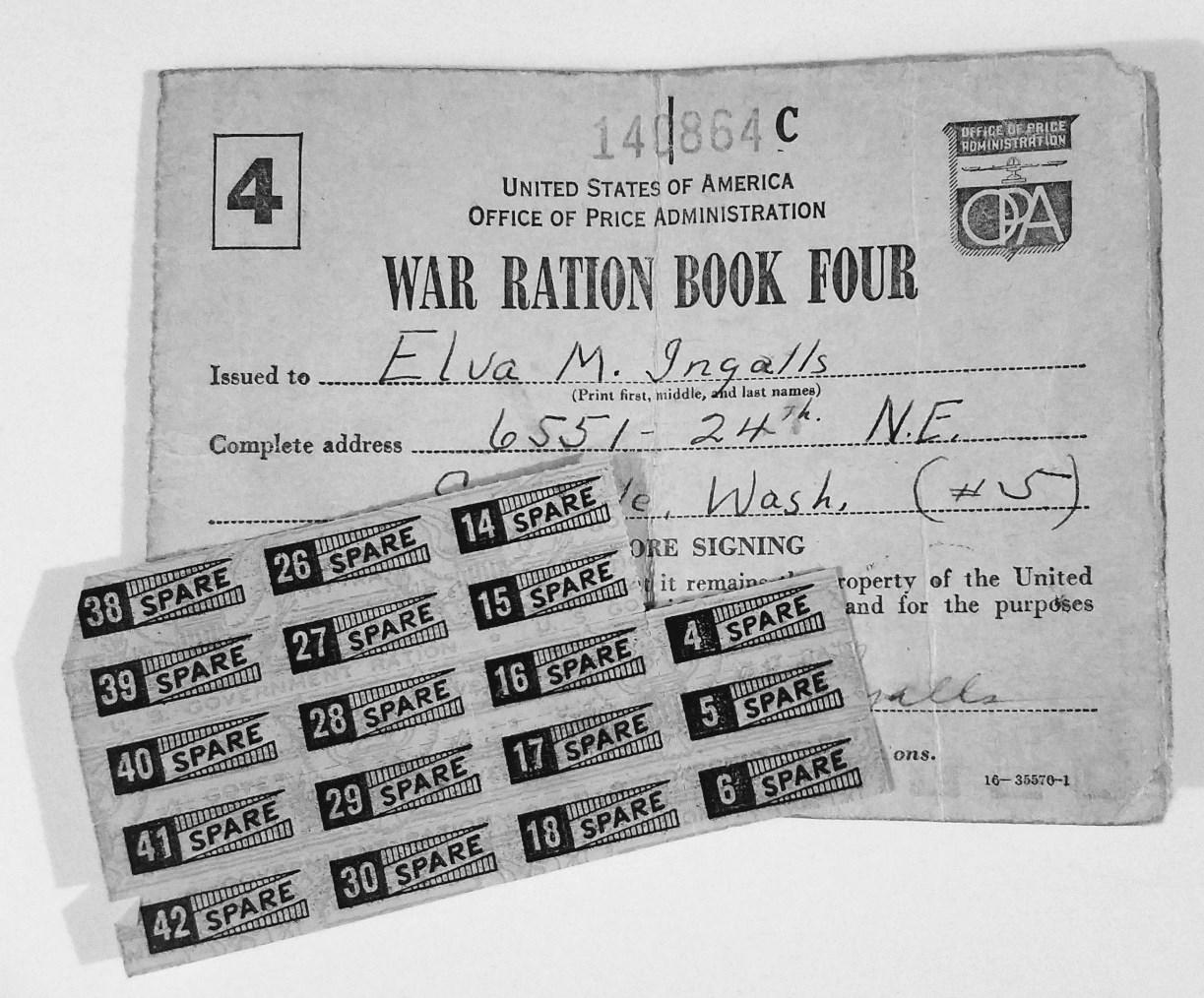
started out liking it but after a long siege I could hardly bear to even look at the jar. We were not poor; it was simply the way things were.
Because of my father’s position in the Coast Guard, we were allotted extra ration books for gasoline. Other rationed items, like sugar, meat, cooking oil, and canned goods were harder to come by. In January 1942, sugar rationing began in Canada as well. In the summers of 1942-1944, the Pamanus would cruise to Victoria and the San Juan Islands. One had to stay a certain length of time to become eligible for these Canadian ration stamps, but we did so and were thrilled to augment our few wartime luxuries that way. We used the sugar coupons we received in British Columbia to buy enough jams and syrup to last us throughout the year back home.
As Catholics we had been raised to believe that one went to hell for eating meat on Fridays. My family had always observed meatless Fridays.
During the war that stipulation was lifted because meat was so scarce. We kids couldn’t grasp why it was suddenly no longer a sin to enjoy meat at Friday dinner. The theology of that was far beyond us.
Women could no longer get silk stockings. Nylons were not yet on the market and silk was needed for parachutes. So the gals used leg makeup much like the tan face foundation we have today. Then, since stockings all had seams, someone had to draw a line up the back of your legs with an eyebrow pencil. All of this for the sake of vanity and style! For less important occasions women wore anklets with all shoes, high heels included. A real fashion statement!
Every household and business was intent on saving all manner of goods. This included paper, rubber bands, string, tin foil, metal bits of all types, and cooking fat. These cans of fat were contributed toward the manufacture of munitions. Some families rendered the fat to make their own soap. Anything that was potentially reusable was saved and recycled.
Adults were encouraged to become blood donors on a regular basis. Blood was needed both for our wounded troops and to be stored at local hospitals should disaster occur.
an older sibling or friend. We felt fortunate to get them in most cases. I got several nice things from Mary Elizabeth Partlow, a friend of the family. My own things always had to go to much younger children because I was so short. My cousin Mary Hentschell and friend Nancy Ingham soon grew too tall to wear most of them. My mother made many of my clothes and her own, even tailoring coats and suits. Later on she made all of my dancing costumes and formals when I was in high school.
Everyone was sewing, knitting, canning, saving, and gardening to help the war effort. Patience became a true virtue since there were lines for many of the rationed goods, when available. Medical services were in short supply with so many doctors and nurses assisting the troops. Unless there was an emergency, even a visit to the dentist or doctor could mean a long wait. I don’t remember people being irate or ill-tempered through all this. It was simply the reality of being at war.
Clothes were worn until they were used for rags, for patching, or for making quilts. Better garments were handed along to another wearer. We children all wore hand-me-downs from
Now we need to address Victory Gardens, the government program that encouraged civilians to grow their own fruits and vegetables. Grandpa Ernie had one of the town’s biggest and best gardens. He struck a deal with Charlie Miller, our neighbor, who owned a large lot adjoining his home. My father offered to plant and maintain his Victory Garden on Mr. Miller’s lot, and the Millers were free
to help themselves to the produce. My father read up on vegetable gardening and then undertook it with vengeance! Everything he touched, planted, weeded, or watered absolutely prospered. What the Mallorys and the Millers couldn’t eat or can was passed on to numerous friends and relatives.
I loved the fresh peas right off the vine and the strawberries. But like every
other kid, I hated having to work in the garden.
Worse than picking the fresh produce was the canning process. In Olympia we had a U-CAN-M. People brought in fresh vegetables and paid a few cents per item for their finished canned goods. But the process meant the produce had to be thoroughly cleaned,
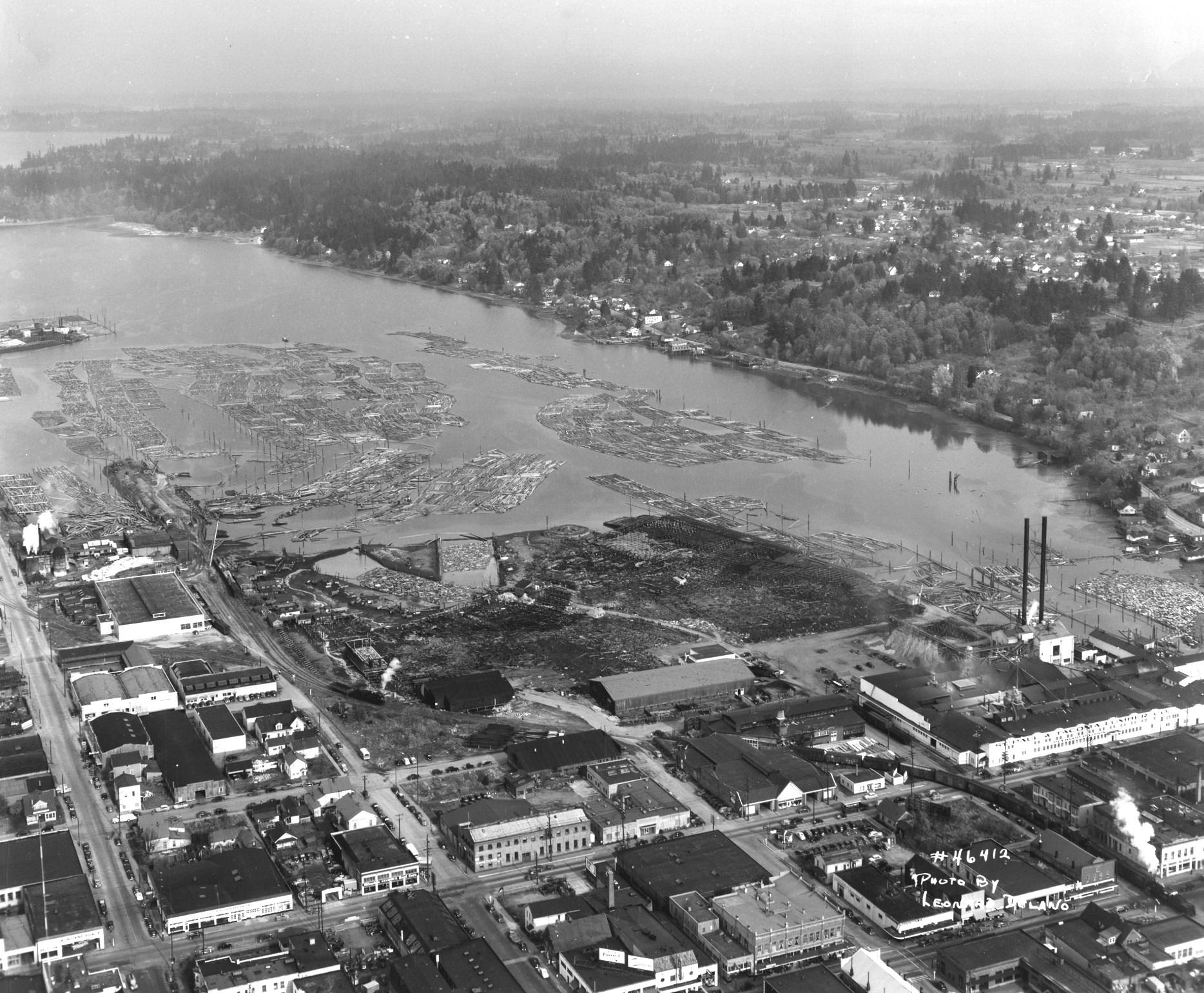
cut to size, dunked in hot and cold water, and finally placed in a can. It was a long, hot, messy, steamy job, always done in the heat of summer. I hated going there with my mother! It was my idea of what purgatory must be! It was one of those things simply to be endured.
We had a cadre of service people on the homefront, primarily the allimportant Air Raid Wardens. They were issued a special ID card, helmet, arm band, and a flashlight. My future father-in-law, Calvin Wood, was fingerprinted as an official Air Raid Warden, Serial No. 55957, on December 5, 1942. These neighborhood guardians had various responsibilities, but chiefly they were to oversee black-out procedures and to be on the look-out for enemy aircraft. On both the east and west coasts, invasion was considered a real possibility.
In Olympia the wardens also enforced the town curfew. Everyone had to be off the streets by 10 p.m. unless one had important business. Obviously, there were cars out and about but no loitering was allowed. The auto headlamps were blacked out with tape across the top half so the light shone only downward. When I first visited London in the 1970s, I was amazed to see cars driving at night with no lights, a carry-over from the war.
shutters were drawn across all windows so that no light shone from the buildings. The globes of the street lamps were painted olive drab so they would be greatly subdued. The object of all this was to make the cities far less visible from the air.
Certain structures in Olympia, such as the basements in the high school and post office, were deemed secure enough to substitute for bomb shelters in case of attack.3 Even the basement of our home was so outfitted if the worst occurred. There was no bathroom in the basement so it would have presented some problems to those assembled.
At St. Michael’s school we practiced air raid drills. Additionally the nuns assigned each of us another home to which we should go during a raid. I was to go home with Jo Ann Joyce, who lived around the corner, if I needed help and my parents weren’t available. I suppose Jo Ann and I were to walk to her house, or ride our bikes, with bombs raining down on us.
I haven’t a clue what plans they had made for the children who lived outside of town. Most of those kids came to school by bus and would have had great difficulty getting home. It all seems pretty silly now. In reality, I expect the nuns would have ushered us into the basement lunchroom to pray. That seemed to be their answer to most crises.
The wardens in Olympia also made sure that heavy curtains, shades, or
An aerial view of the Boeing Company Plant No. 2 in Seattle. The neighborhood at the top of the photo is real, but the “neighborhood” occupying the middle ground of the photograph is actually the roof of the manufacturing plant, complete with fake houses, streets, and trees. The camouflage design was attributed to William Bain Sr., a Seattle architect, and John Detlie, who had been an art director at MGM Studios before the war. Photo courtesy of State Library Photograph Collection, 18511990, Washington State Archives, Digital Archives.
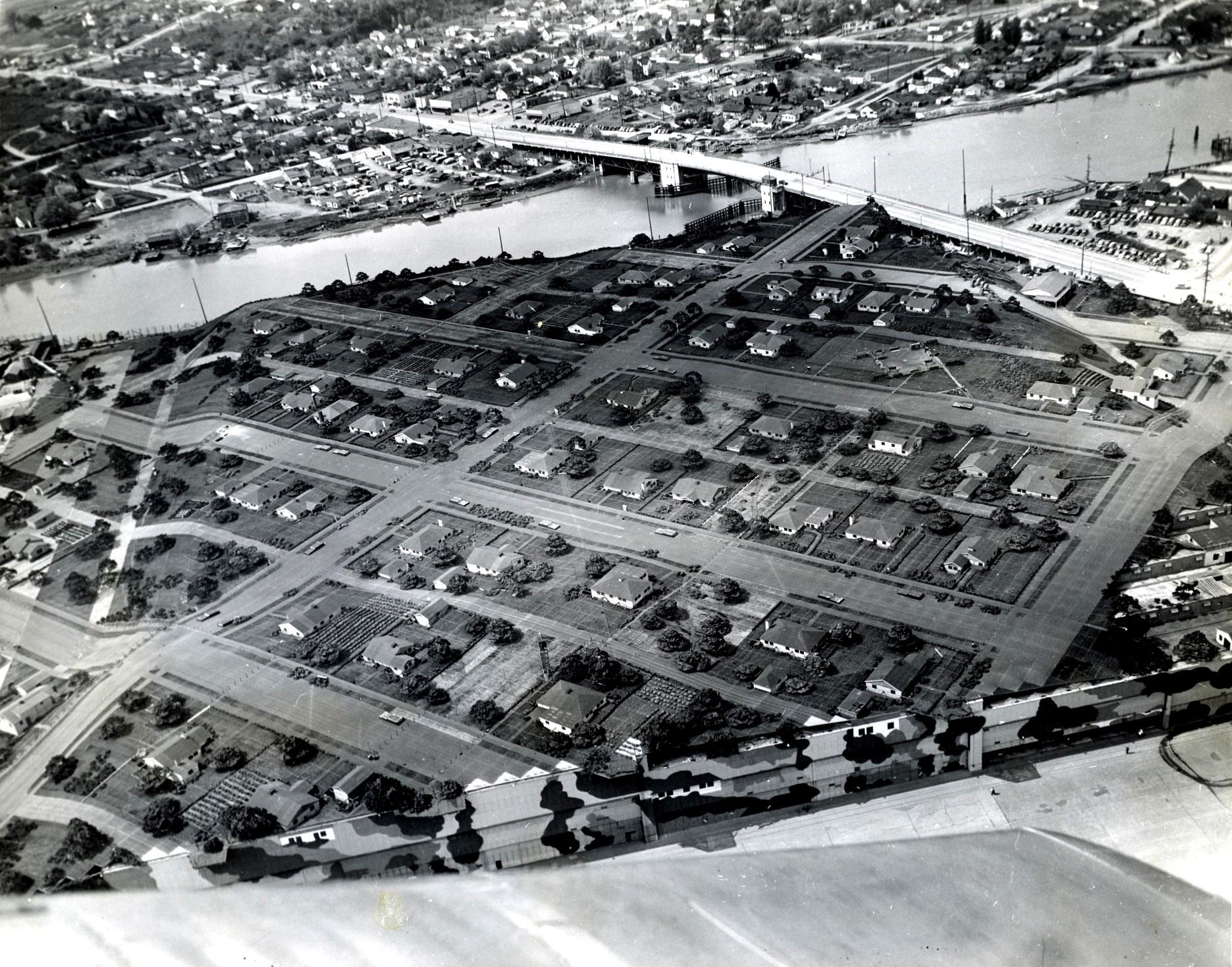
We had a whistle at the lumber yard that could be heard all over town. No doubt that was to be used to signal an air raid and then to give the “all clear” blast. I don’t recall any civil defense sirens but there must have been some. My father told me about air raid
practices when sirens throughout the city sounded the alarm.
Heavy black rubber models of both enemy and United States aircraft and ships were available so the wardens could familiarize themselves with their
specific shapes. Kids were sometimes given these as toys. Today, of course, they are collectibles. Charts illustrating the ship and plane profiles were also available. Every boy in school could describe and/or draw the different aircraft. Barrage balloons were erected along some parts of the West Coast. These were large gas bags, about 40 feet long, which were shaped like cigars with fins. They were attached to the ground by braided steel cables. These were sent up several hundred feet to damage incoming aircraft that might be en route to bomb or strafe the cities. Serious business!
Boeing Aircraft, located south of Seattle, was considered a prime target. The plant covered several acres. The facility was completely camouflaged, covered with a suspended material that anchored fake trees, houses, and cars. From the air it resembled a suburb, not a giant manufacturing plant. I remember driving by and being amazed at the clever disguise.
Another interesting aspect of the war years was that we school children received hot lunches at school to supplement our sandwiches from home. Every day two or three mothers would come to St. Michael’s to make hot cocoa or soup to feed our small school population. My mother was one of those who helped with this chore. I used to love it when the moms made either navy bean or split pea soup, which they served in heavy crockery mugs. My family never made those at home so I considered them a great
treat. It was only during the war that it was deemed important for us to have this hot food at noon. No doubt it was because of the frequency of meatless meals that our nutrition became such a concern. To me it was a reprieve from the same old boring sandwiches!
Children and adults were encouraged to contribute money to the war effort. In fact, a withholding tax was instituted during WWII as a “temporary” measure to help with the costs. Additionally, huge war bond drives were conducted, many of them using favorite movie stars of the day as part of the promotion. As children, we purchased savings stamps at school or at the post office for 25 cents, a dollar, or five dollars each and pasted them into specified books. When one had collected $18.50 worth of stamps, the book could then be traded in for a $25 Defense Bond which came due for payment in ten years. Parents were encouraged to “Buy Bonds” on a weekly basis from their paychecks. My grandfather Kenney was a great one for buying bonds and often gifted us children with them at Christmas or on birthdays. I believe mine were cashed in about the time I left for college.
Even wartime money underwent significant changes. Pennies were no longer made of copper, but steel. Nickel became scarce so the five cent pieces were made of one-third silver instead. And tax tokens emerged. Some were made of pressed cardboard
and some of celluloid. Plastic was not yet widely available for public use.
Propaganda was big business during the war. Everything was “V FOR VICTORY!” Winston Churchill popularized the famous victory symbol of two fingers raised in the form of a V, and it swept the country and the free world. You must realize that the press, and consequently the American public, were only told what the government wished them to hear. Our war news was government-sanctioned news. Letters to and from those in the service were censored so that important information could be deleted. National security was a top priority.
Posters were everywhere in the post office, the library, on houses, in shop windows, etc. The Germans and the “Japs” were always very graphically portrayed as cruel and ugly, crushing innocent victims. The treatment of their prisoners was characterized as brutal and inhuman. Often Tojo, the Admiral of Hirohito's fleet, was shown with great yellow fangs dripping with blood. Nowadays you might look at one of these and chuckle. As you might expect, these posters portrayed the Allies as courageous, attractive and strong, with all the virtues of a Boy Scout. Many propaganda pieces were designed by well-known American artists, including Thomas Hart Benton.
Slogans were everywhere as well. “Loose Lips Sink Ships” was a favorite. If you knew someone in the armed
World War II poster by artist Wesley Heyman shows a banner with a gold star, which signified a serviceman killed in battle. The poster was created in 1944 by the Government Printing Office for the Office of War Information. Image courtesy of Library of Congress.
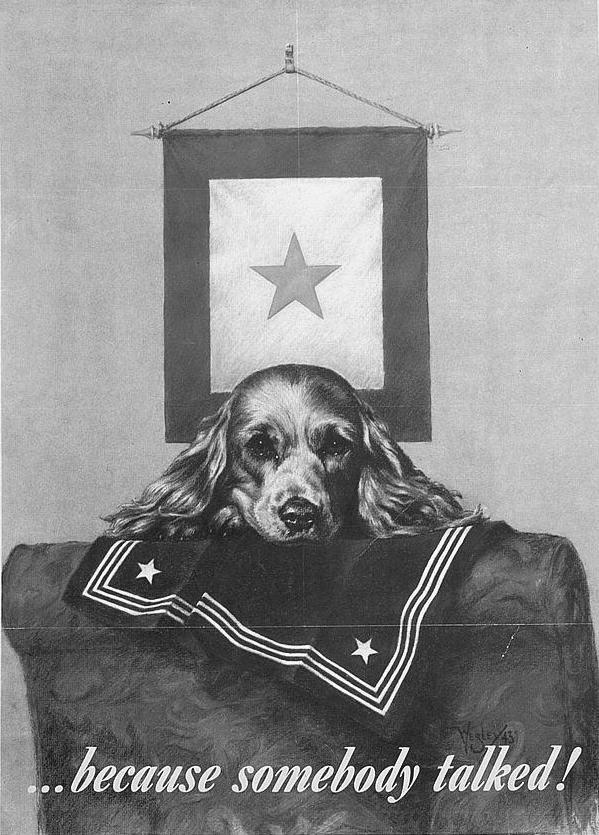
services or a defense plant, you were urged never to disclose anything that could provide details to the enemy. And for sure these enemy agents were lurking about with large, grotesque ears to overhear any damaging bits of information.
The other little characters that became part of the homefront scene were the gremlins. They were imaginary
creatures much like “E.T.,” often green and strange looking, who caused mishaps. If a bus wasn’t running or there was a power outage, it had been caused by a gremlin. We had stickers of the funny characters that adorned our lunch boxes and school notebooks. During the war “Kilroy” appeared as well. This began when a man named Kilroy had been
inspecting tanks. As he completed each one, he drew the little face and left the words “Kilroy was here.” It became one of the quirky symbols of the era.
Because Olympia was so near Fort Lewis, soldiers were a regular sight on the streets, in the shops, churches, movies, and buses. Covered wooden “ride shelters” were erected along the main highway between Olympia and Seattle with signs reading “Give a Serviceman a Lift.” If you had an empty seat in your car, you offered servicemen a ride as far as you were going. No one seemed worried about this practice. After all, these were “our boys.” They were someone's father, brother, or husband. Of course they were honest, upstanding, and lawabiding.
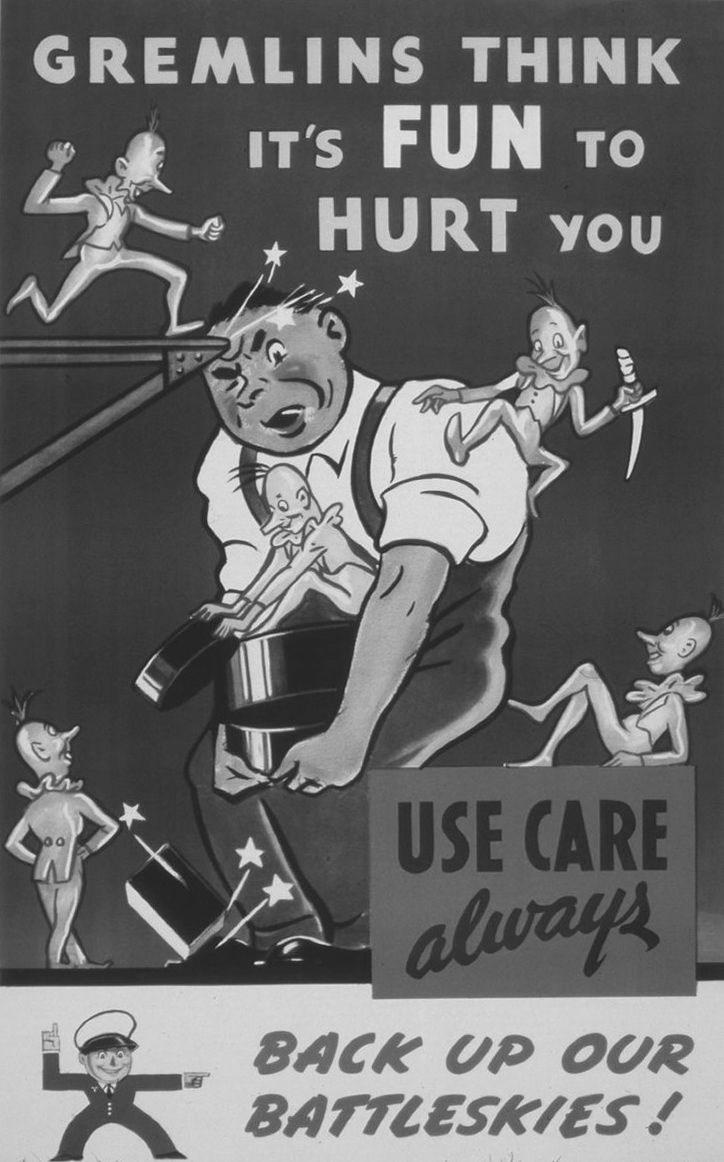
After church on Sunday my mother often chatted with the servicemen out in front. If she found one or two who were pleasant and available, she invited them to come home with us for Sunday dinner or a summer picnic. Once I recall she invited a couple of soldiers with very thick southern accents to go boating with us. One replied, “Oh, thank you, Ma’am, and I’ll be glad to row.” That was hardly necessary aboard my father’s 38footer.
I especially remember a young soldier from Brooklyn named Paul. He was Italian, handsome, and so very nice. He came to our house quite often and regaled me with stories of a very strange dish called pizza. It sounded
“Kilroy was here” was a popular piece of graffiti scribbled at innumerable locations during World War II. Image courtesy of KovacsUr, Wikimedia Commons (accessed February 20, 2020).
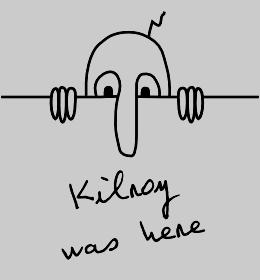
Since I was very busy with my dancing lessons, I became part of the local USO (United Service Organizations) along with several others in Mrs. Mary Sweeney’s Dance School. Groups of entertainers were gathered to stage little shows for the troops. Our local group traveled to Madigan Hospital at Fort Lewis during the years 1943-45 to entertain the wounded. About every two months the dance school would get a call and several of us would go by bus to do a few tap numbers. My first dance partner, Patty McNamara, and I did comic routines. Later Ann Barker and I did a straight tap as a twosome.
dreadful! He assured me it was wonderful and that someday I would enjoy it. Paul stayed in touch with my parents at Christmastime for some years. After the war we received an invitation to his wedding in New York. Obviously our hospitality had meant a great deal to that young soldier so far away from home.
Reed Ingham wrote to me, recalling that my mother had brought a young GI to their home to play their baby grand piano. He evidently was a superior musician and gave a wonderful, classical program to a select few who sat around their living room.
There was always a singer or two, perhaps Mac MacDonald the magician, Dick Swanson on the accordion, and Victor “Tiny” McNamara on the piano. Tiny was well over six feet tall and had a funny number where he played the same tune in many different tempos, e.g., as a march, a waltz, a polka, etc. He had a story about “Freddy” who was hired to accompany the silent pictures at the movie house. But Freddy knew only one tune. The patter began like this; “Freddy only knew how to play ‘Over the Rainbow’ . . .” On the screen came a scene of our soldiers marching at Fort Ord so Freddy played this tune as a stirring march. The next scene depicted the funeral of some serviceman or dignitary, so suddenly Freddy’s Rainbow became a dirge. Next you’d see the GI’s at the Stage Door Canteen doing a lively jitterbug
and “Freddy” would turn to an appropriate rendition of the same old Rainbow. Last, but not least, the scene changed to a debutante’s ball and Freddie would swing into a beautiful waltz version of his favorite, and only, tune. Really, it was funny! We thought Mr. McNamara was an absolute genius on the piano.
Everyone’s favorite in the group was an old vaudeville entertainer named Burt. Burt had been in minstrel shows as well. He would come on with lots of jokes and patter and would don his “black face” makeup as he did so. Then he’d do some more numbers from the minstrel show, complete with an accent. My favorite song of his went like this:
I went to see my girl the other day,
Slip on something, you’re going into town.”
So she slipped on a bar of soap and came right down!
This was followed by a lot of googleyeyes and a few “shuffle off to Buffalo” dance steps. Then he’d swing into another silly ditty. The soldiers loved it! Burt always brought down the house. Today, these mocking portrayals are rightfully judged unacceptable.
Later in the act he’d bring Ann and me out on stage. Then we did a tap number to the “Dark Time Strutter’s Ball,” wearing shiny black jackets, red pants, and white gloves.
Even in Olympia we had a USO Center where servicemen and women could pong or cards. On weekends the local ladies
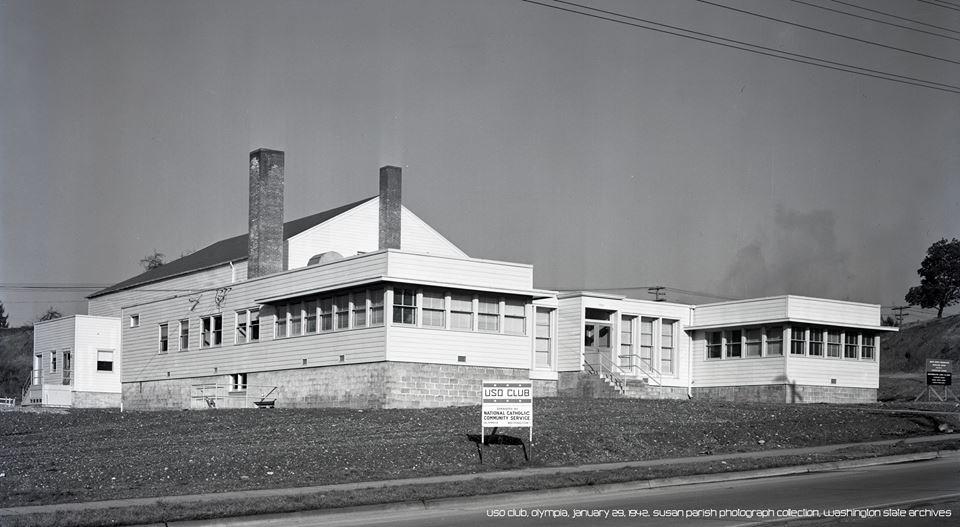
served coffee and donuts while the men would often fix hot dogs. Older girls were permitted to dance with the soldiers. It was all considered quite proper, with punch, cookies, and chaperones. After the war my dad raised funds, I think from the Elks, to convert the building into the Olympia Community Center. We high-schoolers held dances and parties there. I attended a few but my mother much preferred that I socialize in private homes, particularly in our basement recreation room. That way she could be sure none of the boys turned out the lights!
Most civilians did very little traveling during the war years. Gas rationing curtailed use of cars and buses. Plane travel was a great rarity and most aircraft were produced for the military or to carry the mail. Trains were running but were always jammed with people. The sentiment always was “give your place to a serviceman.” Those on furlough or needing to return home for family emergencies had first priority. A relative, George Miles, passed away during the war years, and as a civilian his daughter, Kathrin, was unable to purchase a train ticket to Los Angeles to attend the funeral. Resourceful as she was, she and her husband, Calvin Wood, located a naval officer at the train station and asked him to purchase her a ticket as if she were his wife. He agreed and that allowed her to attend her father’s funeral in southern California.
In the summer of 1943 I traveled by train with my parents’ housekeeper, Francis Guiberson, back to her family home in Iowa. Her fiancé, Lewis Sergeant, was working in the lumber mills for the war effort, so perhaps that gave her the opportunity to visit her family. I must have gone along as her child. Frankly, I can’t imagine why she wanted to take me with her; maybe my folks paid her to do so! But I do remember the train ride of a few days and nights. We sat up all the way, jammed in with people sitting on the arms of the seats and perched on the luggage. We had a hamper of food for the first part of the trip. Getting into the dining car and the bathrooms meant waiting in long lines. But I did get to see Chicago, Lake Michigan, Marshall Field’s Department Store, and the Lincoln Memorial at Springfield, Illinois.
We saw a lot of corn growing in Iowa. That’s also where I saw my first large snake, named Henry, which a neighbor lady kept to rid her barn of mice.
I’m still amazed that my parents let me go off on such a trek during wartime. Nothing was easy about the whole adventure. Perhaps they felt I would be safer in the Midwest than on the Coast. In Iowa they had no blackouts, curfews, or air raid wardens. They knew no one was interested in bombing them! In actuality my parents probably let me go to be a companion to the housekeeper. Good help was very hard to find and to keep. Perhaps I was the insurance policy that she would return to Olympia and her job with them.
We had four years of this wartime experience. As a child it seemed quite serious but also rather fun and exciting at the same time. When we learned that Hitler and Mussolini had been defeated and killed, there was great joy. But it wasn’t until the U.S. dropped the atomic bombs on Hiroshima and Nagasaki that Japan finally surrendered. We were fully prepared as a nation to do whatever it took to save our own forces from having to actually invade Japan. We all knew how the Japanese, mostly civilians, had been killed in those two bombings. But generally the public sentiment was “they got what they deserved.” The news wires were filled with stories of Japanese atrocities inflicted on war prisoners and Chinese civilians, so there was little sympathy, if any, for the Japanese nation, its leaders, or its people.
And so WWII ended on August 15, 1945 on what was known as V-J Day or Victory in Japan Day. Once again the news came by radio. It was a sunny, summer afternoon and there were friends playing at my house. As soon as we got the word, we cajoled my mother into driving us through downtown. Everyone had the same idea! Helen McKay Jacobs said her mother drove Helen and her sister Jean into town from their summer camp on the bay so they could join the celebration. The loud whistle at the lumber mill was blasting; shopkeepers poured out of their stores; government workers were everywhere on the
Capitol grounds; and people were swarming all over the streets. Everyone was shouting and screaming, especially the children leaning out of the car windows. It was a great hullabaloo! People made confetti and were throwing streamers of sorts from the higher store windows. Every car horn in the area was tooting away amid the din.
What a gay and raucous time! I’m sure there were parties and dances that followed but we youngsters simply returned home with our mothers. No doubt we finished off the warm afternoon running through the sprinklers on the side lawn or going to Ken Lake for a swim. My mother had dinner to prepare and my father would finish up his work at one of his apartments and head on home, too. Back to a more routine life in our small town.
I’m certain that with my twelve-yearold maturity, I pictured life in Olympia as a static thing, perhaps with some adjustments for peacetime. But great transformations had taken place, nationally and globally. Many values, attitudes, and standards were undergoing change. Technology had taken a giant leap forward. Much of Europe and Japan lay in rubble and those countries were in need of assistance to rebuild. A world economy and new ideologiesemerged.
The United Nations soon became a reality. My uncle Frank Kenney was a Secret Service agent assigned to the White House during the war years in Roosevelt’s and Truman’s administra-
tions. He and another agent were selected to carry the newly written United Nations charter from San Francisco where it was signed, to the U.N. headquarters in New York City. He did so with the case manacled to his leg. In the event of a plane crash, his instructions were to release the parachute on the container to save the document. He was to go down with the plane. In his memorabilia was a photo of the case and a passenger list from that plane trip.
Change was everywhere. It was occurring not only in New York, Berlin, Tokyo, Milan, and Moscow, but in Olympia, Washington as well.
1 WWI poster, “Let us all remember that in order to win a lasting peace, Germany's military power must be forever crushed!” The Italian Relief Auxiliary of the American Red Cross 310, 58 East Washington Street, Chicago, original in the Huntington Library, Prints and Ephemera Collection, World War I Posters and Ephemera, item priWWI_S_157.
2 Senator Rush Holt Sr. (D-WV), Speech on the floor of the U.S. Senate, Congressional Record, Senate, April 8, 1940,page 4135.
3 “Owners of Buildings Here Take Air Raid Precautions.” Spokane Daily Chronicle, January 14, 1942, page 6. These voluntarily-established “refuge
Secret Service agent Frank Kenney, shown at the upper left, helped to transport the United Nations charter across the country. Photo courtesy of Michael M. Wood.
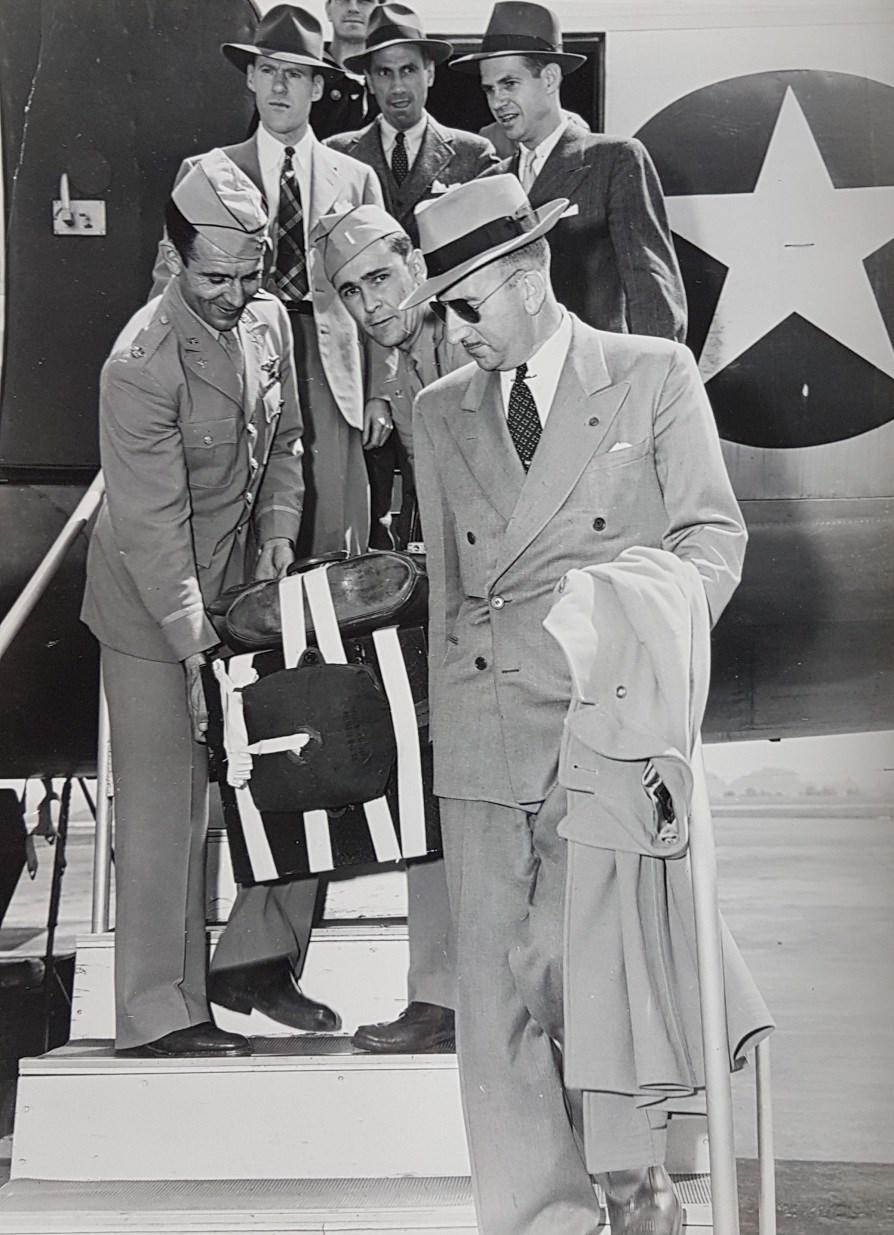
rooms” were to offer underground shelter for a short period of time.
Sharon Mallory Wood is the daughter of Ernest Mallory and Grace Kenney Mallory, and the granddaughter of Frank Kenney.
Authors of historical non-fiction books who rely on human interest stories to drive the narrative can’t help but wonder if they uncovered the best of the best tales prior to publication. Once the ink is dry and the presses roll, there’s no room for additions, or subtractions.
From October 2018 to January 2020, I attended book events throughout the Pacific Northwest to talk about A Deadly Wind: The 1962 Columbus Day Storm, my non-fiction, book-length treatment of the most destructive windstorm to strike the region in recorded history. At some forty book talks, from Bellingham, Washington to Eugene, Oregon, I waited for someone in the audience, which always included a fair share of survivors from the October 12, 1962 windstorm, to offer up a unique, storm-related experience that would leave me saying, “Dang, I wish I would have heard that story while I was researching the book.” Granted, I heard some anecdotes worthy of inclusion in the book. There was the little boy on Olympia’s west side he’s now in his 60s who was knocked unconscious when the hurricane-force winds lifted him off his feet
and slammed him into a telephone pole. But I have a story or two in the book of storm victims flying through the air and suffering subsequent injuries. So far, so good.
Then my bubble burst at a 2019 holiday season book-signing event with fellow South Sound authors hosted by the Olympia Tumwater Foundation at the historic Schmidt, Brewmaster’s, and Crosby houses in Tumwater. South Sound historian Deborah Ross asked me: Had I heard the story about the Olympia police chief and his assistant, who were fired for malfeasance the night of the Columbus Day Storm? I gulped, shook my head and said: “No.”
My ensuing research, guided by Ross, uncovered a story I definitely would have included in the epilogue to A Deadly Wind. Here it is:
Ten days after the Columbus Day Storm killed dozens, injured hundreds and damaged more than 50,000 homes in Washington and Oregon, the lead story on the front page of The Daily Olympian reported that Olympia Mayor Neil R. McKay had that morn-
ing fired Olympia Police Chief Roy L. Kelly and his assistant chief Wilbur H. Shepard. They were charged with violating direct and written orders of the Olympia City Commission which disallowed police officers from drinking alcohol while on the job or having alcohol of any kind in the police station, unless it was being held as evidence in a criminal case. The drinking charges against Kelly and Shepard stemmed in large part from the night of the Columbus Day Storm.1
The two police officers had been confronted by McKay on Friday, October 19 and given until 10 a.m., Monday, October 22 to resign. Kelly and Shepard chose not to relinquish their jobs, so the mayor relieved them of their duties after the Monday morning deadline passed. Named interim police chief by the mayor was W. Fred Derrick, 53, a former executive officer in the Washington National Guard. The two police officials accused of violating the city’s municipal code of conduct, which had been approved by the city commission in October 1961, were notified they had ten days to appeal their firing to the Olympia Civil Service Commission, which would conduct a public hearing and determine their guilt or innocence. In the meantime, they were suspended without pay.2
Thurston County District Court Judge Sam Meyer displays a newspaper clipping that details the role his father, Olympia City Attorney Ernest L. “Bud” Meyer (middle left in portraits), played in the city’s firing of Police Chief Roy Kelly in 196263. Photo by John Dodge.

In refusing to resign, a defiant Kelly had his attorney, Frank Baker, deliver a letter to McKay, which read, in part
“.
I have devoted nearly twenty years to the welfare of the City of Olympia and have served five administrations. Without hesitation I feel my
. .
At the Olympia City Council meeting held on October 23, 1962, Mayor Neil McKay announced that Roy Kelly and Wilbur Shepard were being removed from office. Olympia City Council, Minutes, 1859-2018, Washington State Archives, Digital Archives.

record stands on its merits. If any charges are to be made against me, it is my further decision to contest any allegations with all my strength and ability.”3
Both men appealed their firings, setting the stage for civil service commission public hearing November 15-16, 1962. Some 150 citizens packed the city community center the first day of a hearing, which drew front page coverage in The Daily Olympian. The hearing pitted Olympia City Attorney Ernest L. “Bud” Meyer, 46, against Olympia attorney Frank Baker, 40, representing Kelly. The two men were among the most well-known and respected of the 30 or so attorneys practicing in Olympia in the early 1960s. Meyer was Baker’s senior by several years, but the two had much in common. They were both born and raised in Olympia, Olympia High School graduates—Meyer in 1932, Baker in 1939—University of Washington Law
School graduates, and World War II Army veterans as well.
Baker, a standout athlete in high school, played varsity tennis at the University of Oregon in Eugene. After college, he joined the Army and served as a lieutenant in General George Patton’s Third Division in Europe. Just ten days after the Allied invasion at Normandy, France in June 1944, Baker stepped on a land mine on the beach in Belgium and lost his left leg below the knee. “He wasn’t one to talk about his war experiences,” noted former state Supreme Court Chief Justice Gerry Alexander, another OHS graduate, UW Law School grad, and longtime history buff. “Frank was my mentor he brought me into his Olympia practice in 1964.” Baker later served as a Thurston County Superior Court judge from 1969 to 1984, and Alexander was on the county’s highest court with him from 1973 to 1984.
Meyer, the father of eight sons, four of whom became attorneys, was the parttime city attorney from 1960 to 1978. The OHS Class of 1932 graduate was a captain in the Army, stationed in England, then Germany where he served as a war crimes investigator and assisted with preparation for the Nuremberg Trials. His decades of community service included 40 years on the board of directors for Olympia Federal Savings and Loan Association.4
The first witness for the city to testify was prominent downtown Olympia businessman Lee Dawley. Dawley came to Olympia police headquarters the night of the storm to tell officers his employees would maintain a security watch on his buildings, freeing up police for other storm-related responses. Dawley said Kelly approached him and said: “We have all the manpower we need here. You can be helpful by bringing down a bottle of bourbon.” Dawley went home, gathered up bottles of scotch, wine, brandy, and Cointreau and returned to the station. He handed the booze to Sgt. Roy Snyder, who placed them behind the door to the chief’s office. “Was the chief’s request made in jest or in earnest?” Meyer asked Dawley. “In retrospect, Mr. Kelly appeared rather emphatic,” Dawley replied.
During cross examination, attorney Baker asked Dawley if he gave the police chief the liquor as a show of appreciation for the police efforts to protect his buildings. Dawley said he provided the liquor “because the police
chief asked for it. It was the night of an emergency. I took it [the request] as mandatory.”5
The next witness was a familiar name in the Olympia community: Mike Contris, head of the English Department at Saint Martin’s College (now University), the Benedictine college established in Lacey in 1895, and the author of a well-read column in The Daily Olympian called “The Crucible.” He had arrived at the police station to report a broken water line in front of his father-in-law’s house just as the Dawley-Kelly exchange unfolded. Contris testified that he heard someone talking to Dawley, requesting “a bottle for the boys.” Attorney Baker pressed him on the conversation, asking if he was sure it was Kelly talking to Dawley. “The only thing I’m sure is that Mr. Dawley answered Kelly,” Contris said.6
The final two witnesses called by Meyer on behalf of the city were longtime Olympia police officer Bill Wojtech and Olympia City Commissioner Tom Allen. Wojtech said he visited Kelly’s home about 10 p.m. the night of the storm while on duty. Kelly offered him a drink and Wojtech accepted. Meyer asked Wojtech if Kelly was drinking, too. Wojtech said he wasn’t sure; the house was darkened by a power outage caused by the storm. However, Wojtech said, the police chief did have a glass in his hand. Later in the hearing, while on the witness stand, Kelly conceded he had a drink of liquor at home before returning to the police station the night of the storm. Com-
missioner Allen only testified that he and fellow Commissioner Ed Krenik had verbally agreed with McKay that Kelly should be fired, but they didn’t take a formal vote in a public meeting prior to the action.7
After the city rested its case the afternoon of November 15, Baker called his client, Olympia Police Chief Roy Kelly, to the witness stand. Kelly testified that the mayor had never pressed him in the past not to drink during working hours and that the mayor never voiced concerns to him about the way he was running the police department. The police chief said the department responded to some 500 calls from residents the night of the storm and was successful in thwarting any looting or burglary attempts during and in the aftermath of the storm. Next, Baker asked his client if he had asked anyone to bring liquor to the police station during the storm. Kelly said he did not. Kelly said he learned about the liquor, a bottle of scotch, at police headquarters on Saturday, the day after the damaging windstorm. He said he took it home with him on Monday. Baker asked the police chief if he had ever lied to the mayor. “No sir,” Kelly said.8
“Doesn’t it say in here never to drink on duty?” Meyer asked. “Oh, yes. It’s in there,” the police chief responded. “I wonder,” mused Meyer, “if there is any excuse, or reason, you can give this commission for violating your own orders for proper conduct, the mayor’s orders and the civil service orders?” “It depends on the situation,” Kelly responded. “You mean in some circumstances you can disobey orders and in some you can’t?” Meyer asked. “I go along with that—yes,” said Kelly. “Circumstances alter a lot of things.”9
Then it was Baker’s turn to question his witness again. Under questioning, Kelly said he had never been drunk on duty and no one in authority had ever told him in nineteen years as chief that his administration of the department was inadequate. Baker also asked the police chief why he didn’t tell the mayor that three of his officers had stopped in for a drink at the Oyster Bar the night of the storm. “Let’s be blunt,” Baker said. “Wasn’t it because you didn’t want to be a stool pigeon to the city commission on your own men?” “Yes,” Kelly replied. “All the questions they asked, I gave an answer to.”
Under cross examination, Meyer called attention to a green, spiral-bound booklet that contained the code of conduct for the police department adopted by the city commission in October 1961. The introduction to the manual was a message from Kelly, urging his police officers to adhere to the rules spelled out in the booklet.
Holding the pea-green city code of conduct manual, Meyer questioned Kelly again. “Stool pigeon. Squealing. Isn’t that the code of the underworld? Isn’t that the way criminals behave?” The former war crimes investigator pushed on. “Isn’t this Rule 30 what you expect from your men? Isn’t this what the City Commission has a right to expect from you?” “Yes,” Kelly an-
swered. “But it didn’t get it,” Meyer persisted. “No, sir,” the chief replied.10
After almost two days of testimony focused on Kelly, the hearing turned to Wilbur H. Shepard, assistant police chief. The day of the storm was the officer’s day off, but he came to police headquarters that night to assist in the storm response. Later that night,
he, two other police officers, and a city building inspector adjourned to the Oyster Bar for two drinks, then returned to police headquarters. Shepard allowed members of the police force cold, wet, and tired after working through the night a hard liquor drink before heading home Saturday morning. “Would you allow them to do it again?” Shepard’s attorney, David

Schultz asked. “Not in the police station,” Shepard answered. “I’d take them to my home.”11
Questioned by the mayor a few days after the storm, Shepard declared in a written statement that he didn’t visit the Oyster Bar. He later amended his statement to include the Oyster Bar incident. “Did you purposely lie?” Schultz asked. “No, I forgot we went out,” Shepard testified. Throughout his testimony, Shepard admitted to breaking the code of conduct rules, referring to the night of the Columbus Day Storm as an “unusual situation.” Schultz attempted to bolster his client’s case with a character witness, Thurston County Coroner Hollis Fultz, who described Shepard as an honest, hard-working cop.12
The tense, tiring two-day hearing concluded late Friday afternoon, with closing remarks by city attorney Meyer and Kelly’s attorney, Frank Baker, who conceded that his client had violated department rules about drinking on the job and allowing liquor at police headquarters. However, Baker said, dismissal from his job was too harsh a penalty for Kelly to pay. Perhaps a demotion in rank would be more appropriate, Baker suggested. “Kelly certainly wouldn’t be an effective sergeant after being chief,” countered Meyer.
“Hewouldn’tbe.”13
The hearing was adjourned just before 5 p.m. by Civil Service Commission Chair R. W. Weller. All parties involved awaited a ruling by the commission. They didn’t have to wait too long. On
Wednesday, November 21, just before Thanksgiving, the commission ruled in favor of the city’s firing of Kelly. In Shepard’s case they called for a demotion to sergeant and a 45-day suspension without pay. Kelly was not done fighting for his job. His attorney appealed the decision involving Kelly to Thurston County Superior Court while Shepard did not pursue his case in court. Pending the court ruling, Kelly accepted a job as assistant sergeant-of -arms for the state Senate.14
Baker’s legal strategy was to try to overturn the commission ruling on technical points. He argued before Superior Court Judge Raymond W. Clifford that the mayor did not have the legal authority to fire the police chief without a formal vote of all three members of the Olympia City Commission. Baker also contended that he should have been allowed to question the Olympia Civil Service Commission members about their political party affiliations to ensure they were not all members of the same party. In his February 1, 1963 ruling, Clifford sided with Baker, ruling that Kelly had been fired improperly. Clifford said the civil service political party rule was designed to protect civil service employees from being fired for “political or religious reasons.”15
Reaction to the judge’s ruling was swift. Kelly said he felt vindicated, but was likely to resign given the strained relationship he had with city officials. The mayor called for a special meeting of the City Commission later Friday to fire Kelly a second time. Kelly was of-
During the Columbus Day Storm, John Dodge and his family took shelter at the Bill Kilde house. The Dodge house went undamaged, but the Kilde home “had an uninvited guest drop in through the patio entrance.” Photo from It’s the Water News, November 1962, courtesy of the Olympia Tumwater Foundation.

pension. He also vowed to expand the charges against Kelly, claiming the police chief was derelict in areas of “personnel training and equipment maintenance and control.” In addition, the mayor said Kelly had violated a state law prohibiting public employees to receive gifts.16
On the afternoon of February 5, 1963, the Kelly case finally reached a climax. Kelly attended the City Commission meeting, but remained silent throughout. The three commissioners worked through an agenda of routine city business. They then read a resolution into the record, calling for Kelly’s ouster a second time. Before the vote, the commission took public testimony. Olympia businessman Dean Payne addressed the commission.
fered a chance to resign immediately, but he refused, offering instead to resign March 1, suggesting the extra month as police chief would improve his pension. The City Commission was not swayed, but deferred final action on Kelly until its regular meeting on Tuesday, February 5. The mayor said Kelly was in error about his bump in
“During my residence, we have had one of the best police departments in the United States,” Payne opined. “It has been clean. We have had good men who have stayed on because of loyalty to Chief Kelly. None can say he has not done a good job. I wish to lodge a strong protest for myself and other businessmen.” He added, “Personal habits should not enter into it.” After Payne, attorney Baker read a 2,000-word statement into the record in defense of
his client, calling the city heavyhanded and wasteful of thousands of dollars in taxpayer money to prosecute Kelly.17
Mayor McKay asked for any further comment. Hearing none, the 3-0 vote to fire Kelly again was recorded and the gavel banged.18 One of the more scandalous stories spawned by the 1962 Columbus Day Storm drew to a close.
The Sunday Olympian, November 18, 1962, page A-1.
11 “Police Appeal.”
12 “Police Appeal.”
13 “Kelly Out, Shepard Reduced to Sergeant.” The Daily Olympian, November 21, 1962, page A-1.
14 “Kelly Improperly Fired.” The Daily Olympian, February 1, 1963, page A-1.
1 “Chief Kelly, Shepard Fired.” The Daily Olympian, October 22, 1962, page A-1.
2 “Chief Kelly.”
3 “Chief Kelly.”
4 Interviews with Gretchen Sturtevant (Frank Baker’s daughter), former state Supreme Court Justice Gerry Alexander, and Sam Meyer (Ernest Meyer’s son), March 2020.
5 “Kelly Defends Actions As Police Chief.” The Daily Olympian, November 16, 1962, page A-1.
6 “Kelly Defends.”
7 “KellyDefends.”
8 “Kelly Defends.”
9 “Kelly Defends.”
10 “Police Appeal Decision Pending.”
15 “If Kelly’s In, He’ll Be Out.” The Sunday Olympian, February 3, 1963, page A-1.
16 “KellyFiredSecondTime.” The Daily Olympian, February 5, 1963, page A1.
17 “Kelly Fired.”
18 “Kelly Fired.”
John Dodge is an Olympia-based journalist and author. He worked as a reporter, columnist, and editorial page writer at The Olympian for 34 years. He is the author of the Pacific Northwest bestseller, A Deadly Wind, the 1962 Columbus Day Storm, Corvallis: Oregon State University Press, 2018.
On Friday, October 12, 1962 the Pacific Northwest experienced a windstorm for the record books. The 1962 Columbus Day Storm remains the most destructive windstorm to strike the West Coast in recorded history.
The storm was a mid-latitude cyclone with wind gusts topping 100 miles per hour from northern California to central Puget Sound. Over the span of 24 hours, this storm with hurricane-like features traveled more than 1,000 miles from south to north and covered some 75,000 square miles. The death toll in California, Oregon, Washington, and British Columbia topped 60. Property damage in 2017 dollars is estimated at $2 billion to $5 billion. More than 50,000 homes in Washington and Oregon were damaged or destroyed.1
Much of the storm’s energy came from the remains of Typhoon Freda, which had traveled across the Pacific Ocean from the Marshall Islands in early October, parking off the northern California coast October 11, only to be reenergized by a cold air front from the Aleutian Islands in Alaska mixing with warm tropical air from the south.2
billion board-feet of timber in the Pacific Northwest. That’s enough wood to frame one million homes and four times the volume of timber lost in the eruption of Mount St. Helens in May 1980. The volume of timber on the ground was too much for the region’s mills to handle. It fueled the birth of the Asian log export market. The storm battered Thurston County for more than two hours, starting around 7 p.m., Friday. Thurston County property damage was pegged at several million dollars. The storm’s death toll included Yelm residents Wilbur and Carol Archibald, who were crushed by a tree that fell on their station wagon traveling on Bald Hill Road Friday night.3
The storm knocked down some 15
Locally, the peak wind gust registered at the U.S. Weather Bureau station at the Olympia Airport was 78 miles per hour. The wind gauge was at ground level. Peak wind gusts at exposed and elevated areas in and around Olympia were believed to have topped 100 miles per hour, according to anecdotal reports. A front page story on October 14 (there was no Saturday newspaper) in The Sunday Olympian, summed up the post-storm landscape in South Sound: “Added together, a small forest of trees tumbled, lying at odd angles across power lines, cars, houses and
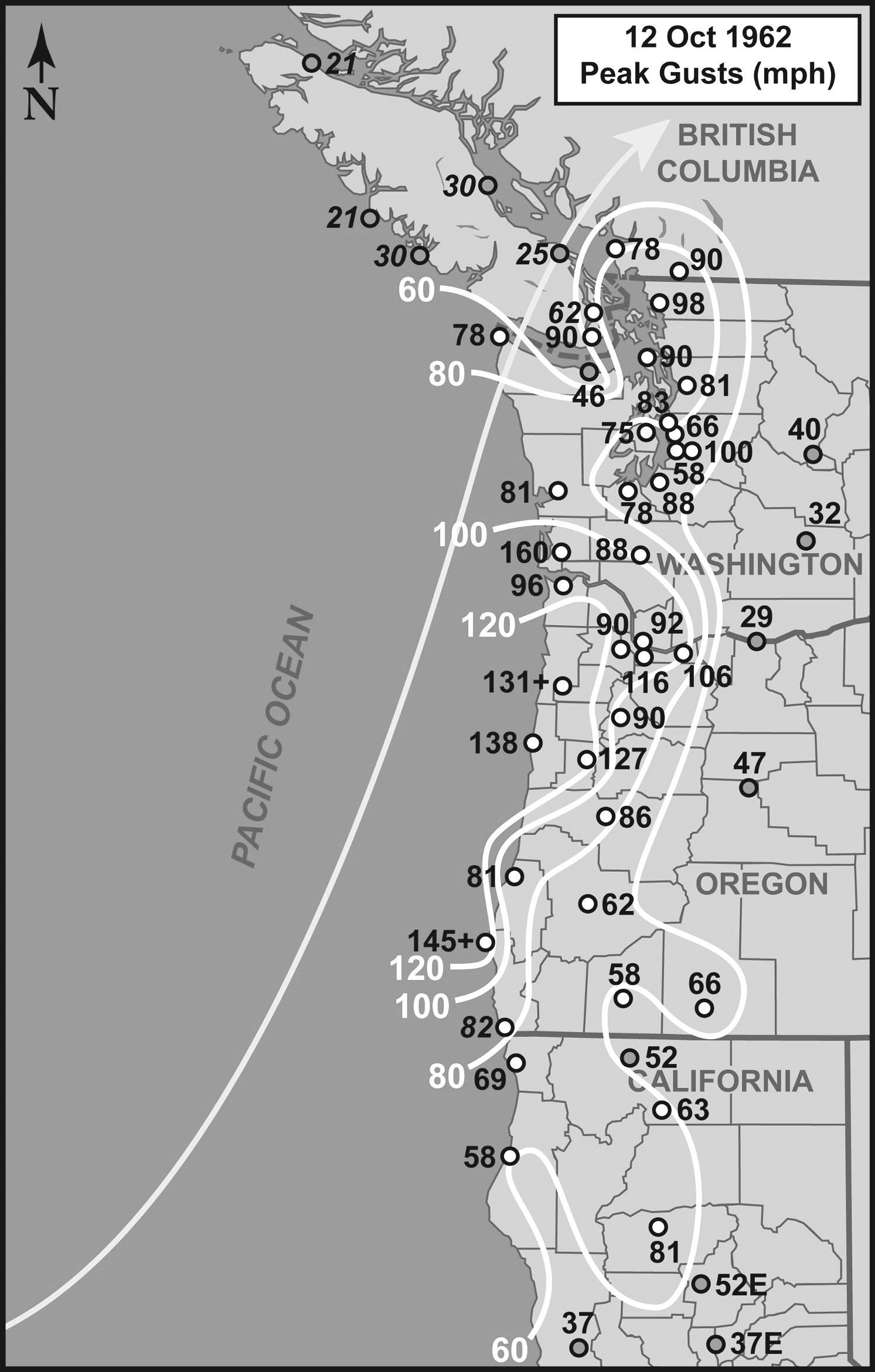
lawns throughout the county. Barns are tilted. Traffic is blocked. Boats broke loose. Crops were ruined. Some youngsters are celebrating. There’s no school.”
Oregon State University Press, 2018.
2 Dodge.
3 Dodge.
4 “No Quick Solution for Storm.” The Sunday Olympian, October 14, 1962, page A-1.
Previous page: This map shows the speed of the peak wind gusts in miles per hour during the Columbus Day Storm of 1962. Numbers with a “+” behind them indicate the top recorded wind speed; later gusts may have been stronger, but the wind gauges were blown away. Map courtesy of meteorologist Wolf Read.
Above: Damage to the Turner property after the Columbus Day Storm. The Black Cat Nursery (now Rainbow Floral) on Pacific Avenue can be seen in the background. The Turners lived in the residence in the back of the nursery. The man is probably Henry Turner, the owner. Photo courtesy of the Lacey Museum.
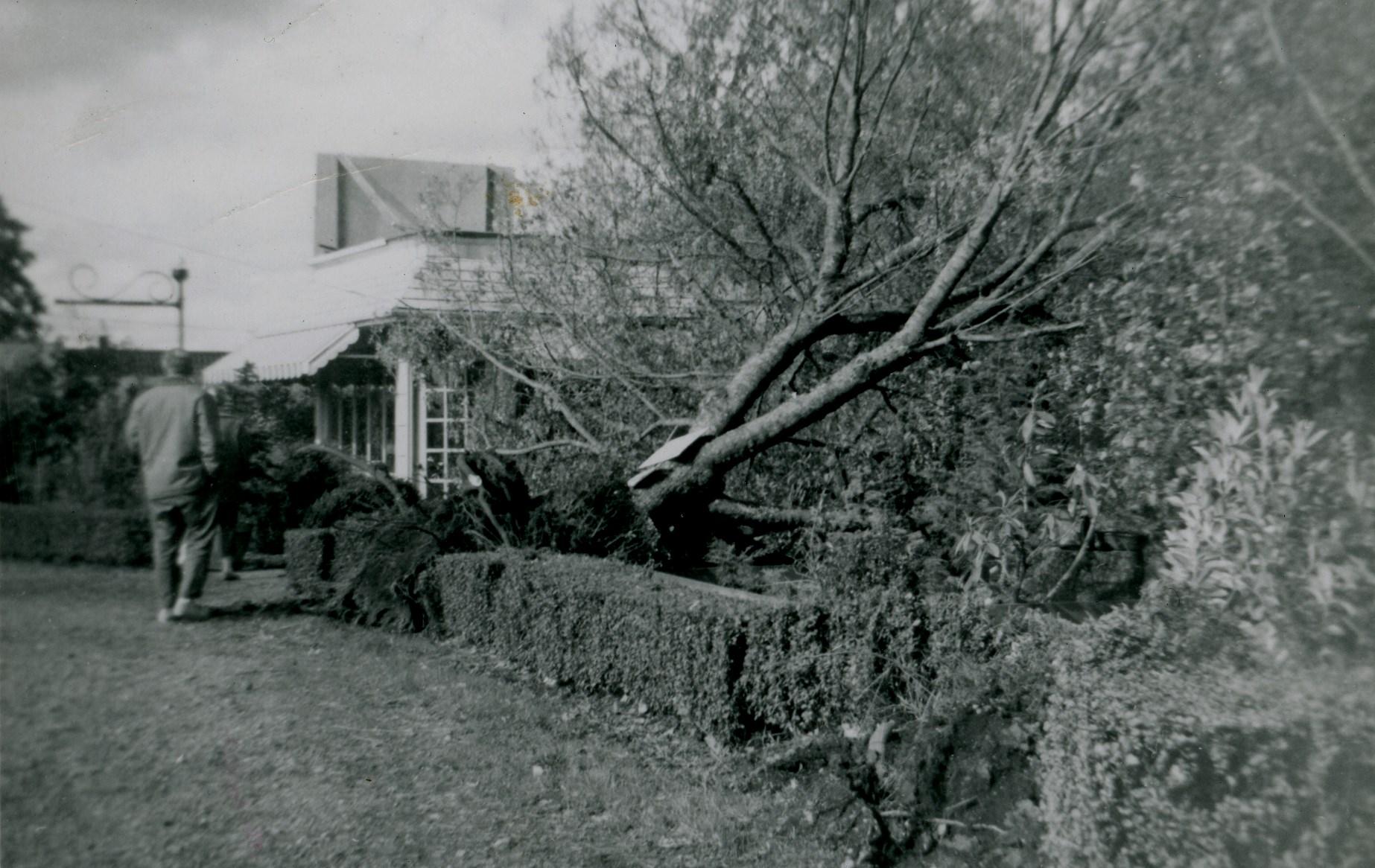


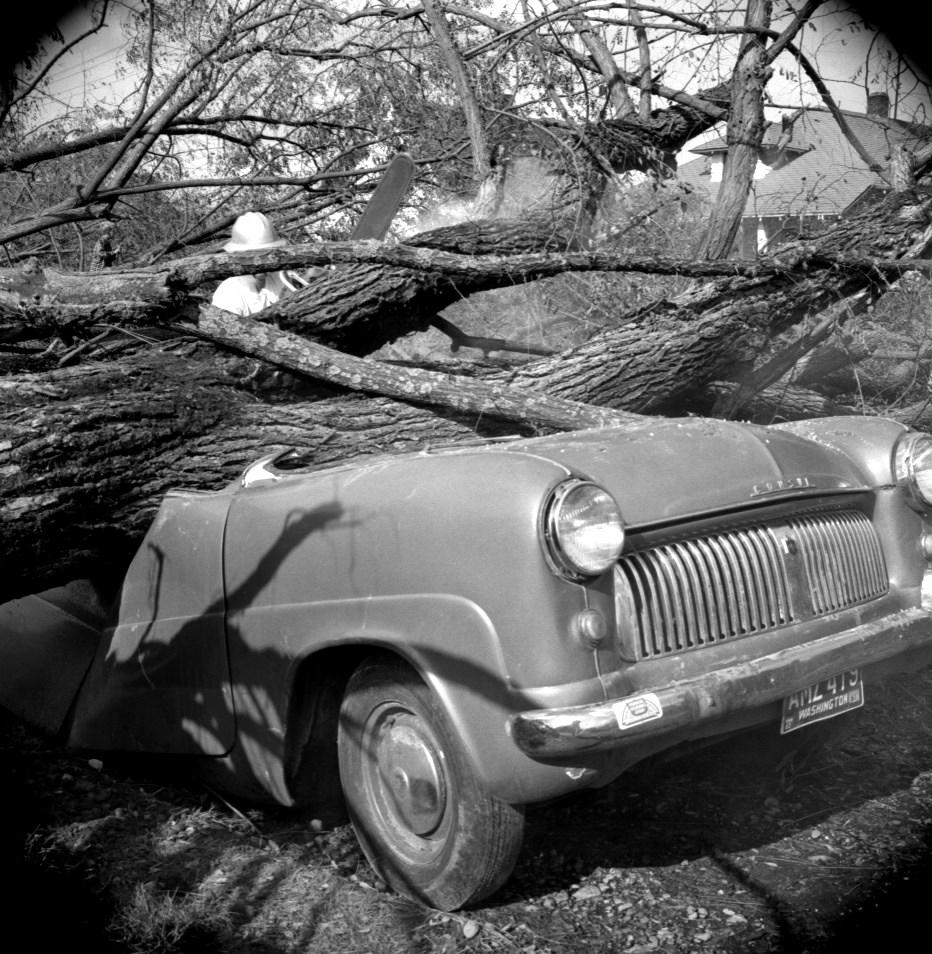

This photo shows Poppy Cannon visiting the Olympia Brewing Company in 1958. In May 1958, Cannon (along with friend Elizabeth Chadwick Carlson, a former Olympia resident whom she worked with on the East Coast) toured the Olympia Brewing Company in Tumwater on assignment from House Beautiful magazine. As food and beverage editor, Cannon was visiting Western Washington researching salmon, nursing home food, and beer. The July 1958 issue of the brewery’s It’s the Water News newsletter published this photo and reported that the women were impressed by both the taste of the beer and the brewery’s “spotless” appearance. The newsletter called Cannon “an internationally recognized judge of fine food and beverages.” In the picture she is examining hops, a key ingredient in beer.
Cannon wrote about Olympia beer in an article “The Changing Taste for Beer” in the October 1958 issue of House Beautiful; the article explored brands of imported and domestic beer. She compared Kirin beer from Japan to Olympia beer and under “Very Special Americans” she wrote:
“According to the slogan, ‘It’s the water’ that makes Olympia Beer so good. The facts seem to bear out this contention. Their pure glacial water comes from exceedingly deep artesian wells, dug through four or five layers of sand, loam, and clay. At various times at-
tempts have been made by the founder, his sons and associates to establish other breweries on the Pacific coast. They used the same equipment, the same ingredients, the same methods and the best water supply in each city but they couldn’t produce a beer that tasted like the true Olympia. The yeast was brought from the Carlsberg breweries in Copenhagen to Washington.”
Poppy Cannon (1905-1975) was one of the leading cooking authorities in the 1950s. She was at the height of her career when she visited the brewery. She had become the food editor for House Beautiful in 1953, a prestigious position as the magazine aspired to be the arbiter of taste in lifestyle for the upper class. She later worked for Ladies’ Home Journal. Cannon wrote a number of cookbooks, but her most famous was The Can-Opener Cookbook (published in 1951 and reprinted multiple times) which focused on quick cooking with prepared ingredients for working women. Her work encompassed both gourmet cooking and shortcut cooking with processed foods.
Article submitted by Jennifer Crooks, a local historian. Among other activities, Jennifer is creating an index to the It’s the Water News at the Schmidt House Archives.
